国际市场营销学课后习题答案
国际市场营销学课后案例分析答案刘向红
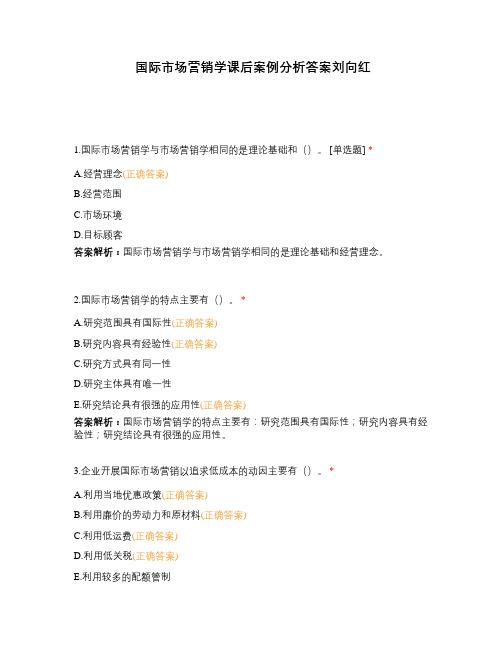
国际市场营销学课后案例分析答案刘向红1.国际市场营销学与市场营销学相同的是理论基础和()。
[单选题] *A.经营理念(正确答案)B.经营范围C.市场环境D.目标顾客答案解析:国际市场营销学与市场营销学相同的是理论基础和经营理念。
2.国际市场营销学的特点主要有()。
*A.研究范围具有国际性(正确答案)B.研究内容具有经验性(正确答案)C.研究方式具有同一性D.研究主体具有唯一性E.研究结论具有很强的应用性(正确答案)答案解析:国际市场营销学的特点主要有:研究范围具有国际性;研究内容具有经验性;研究结论具有很强的应用性。
3.企业开展国际市场营销以追求低成本的动因主要有()。
*A.利用当地优惠政策(正确答案)B.利用廉价的劳动力和原材料(正确答案)C.利用低运费(正确答案)D.利用低关税(正确答案)E.利用较多的配额管制答案解析:企业开展国际市场营销以追求低成本的动因主要有:利用当地优惠政策、廉价的劳动力和原材料、低运费、低关税、较少的配额管制、接近产品的销售市场等。
4.本国政府为了发展国内经济,采取支持和鼓励本国企业到国际市场上开拓经营的政策主要有()。
*A.减税政策(正确答案)B.退税政策(正确答案)C.低息贷款政策(正确答案)D.担保贷款政策(正确答案)E.进口价格补贴政策(正确答案)答案解析:本国政府为了发展国内经济,采取支持和鼓励本国企业到国际市场上开拓经营,即鼓励出口的政策主要有:减税和退税的税收优惠政策、低息贷款、担保贷款、出口价格补贴政策,为企业提供外贸咨询、国际市场信息等一系列配套服务;给具有经营实力的企业向下放进出口自主权等。
5.国际市场营销学的研究对象包括国际市场需求、国际市场营销活动和()。
[单选题] *A.国际市场营销环境B.国际市场营销模式C.国际市场营销进程D.国际市场营销规律(正确答案)答案解析:国际市场营销学的研究对象包括国际市场需求、国际市场营销活动和国际市场营销规律。
国际市场营销学习题及答案
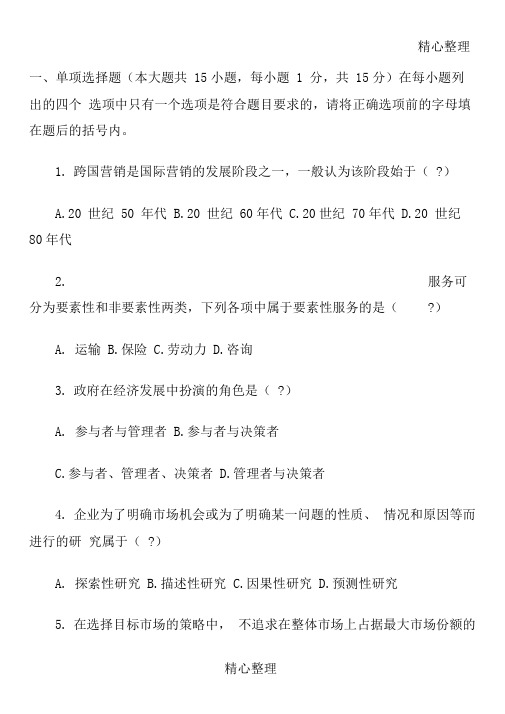
精心整理一、单项选择题(本大题共 15小题,每小题 1 分,共 15分)在每小题列出的四个选项中只有一个选项是符合题目要求的,请将正确选项前的字母填在题后的括号内。
1.跨国营销是国际营销的发展阶段之一,一般认为该阶段始于( ?)A.20 世纪 50 年代B.20 世纪 60年代C.20世纪 70年代D.20 世纪80年代2.服务可分为要素性和非要素性两类,下列各项中属于要素性服务的是(?)A. 运输B.保险C.劳动力D.咨询3.政府在经济发展中扮演的角色是( ?)A. 参与者与管理者B.参与者与决策者C.参与者、管理者、决策者D.管理者与决策者4.企业为了明确市场机会或为了明确某一问题的性质、情况和原因等而进行的研究属于( ?)A. 探索性研究B.描述性研究C.因果性研究D.预测性研究5.在选择目标市场的策略中,不追求在整体市场上占据最大市场份额的精心整理策略为(?)A. 无差异性营销策略B.差异性营销策略C.集中性营销策略D.分散性营销策略6.在产品生命周期各阶段中,企业需要侧重于加强成本和质量控制,增强、维护产品和商标信誉的阶段是( ?)A. 投入期B.成长期C.成熟期D.衰退期7.在波士顿矩阵分析法中,销量增长快、市场占有率低的产品称为(?)A. 金牛产品B.明星产品C.问题产品D.瘦狗产品8.企业在选择服务水平时,除了服务水平的适应性外,还要考虑的一个因素是服务水平的( ?)A. 经济性B.选择性C.独创性D.竞争性9.在国际市场进入模式中,以 "新产品-新需求-国际市场 "为基本格局的是( ?)A. 市场渗透型模式B.产品开发型模式C.市场开发型模式D.多种经营型模式10.按国际上的通常定义,下列项目中不属于服务产品的是(?)A. 保险B.运输C.旅游D.技术专利11.在商品价格构成要素中,最基本、最主要的因素是( ?)A. 价值B.成本C.利润D.边际效用12.收购和创建是跨国公司对外投资的两种方式,与收购相比,创建这种方式的优点是( ?)A. 有利于迅速进入市场B.有利于扩大经营范围C.有利于管理D.失败率低13.企业的定价目标的基本类型有( ?)A. 利润目标、竞争目标、发展目标B.利润目标、市场目标、竞争目标C.利润目标、市场目标、发展目标D.利润目标、市场目标、发展目标14.国际促销的实质是信息沟通的过程,在这个过程中,接收和理解信息的环节是(?)A. 编码B.信息渠道C.解码D.反馈15.国内出口中间商类型很多、特点各异,其中不拥有产品所有权的出口中间商是(?)A. 国际贸易公司B.出口直运批发商C.出口经营商D.国外设在本国的常驻采购商精心整理二、多项选择题(本大题共 10小题,每小题 2 分,共 20分)在每小题列出的五个选项中有二至五个选项是符合题目要求的,请将正确选项前的字母填在题后的括号内。
智慧树答案国际市场营销学(山东联盟-泰山学院)知到课后答案章节测试2022年

第一章1.能够有效地解释企业的跨国经营行为的理论是答案:产品生命周期学说2.国际营销与国际贸易的交易动机都是比较利益答案:错3.多国营销又被称为跨国营销答案:错4.国际市场,又称为世界市场,是世界范围内因国际分工和经济联系而进行商品、服务、技术交换活动的场所。
答案:对5.国际营销和国际贸易均是跨国界的经济活动,二者有类似的理论基础。
答案:对第二章1.市场信息是市场决策的基础。
答案:对2.市场信息的特征包括答案:可压缩性;可储存性;系统性;分散性;时效性3.市场信息系统是由()构成的答案:内部报告系统;情报系统;调研系统;分析系统4.间接资料调研方法也叫做文案调研法或者二手资料收集法。
答案:对5.面谈调查的优势是成本低、速度快。
答案:错第三章1.目前欧盟已经实现了完全经济一体化答案:错2.多变关系主要包括东西方关系和南北关系。
答案:对3.目前主要的区域经济一体化组织包括答案:特惠贸易区;自由贸易区;经济联盟;共同市场;关税同盟4.区域经济一体化对企业国际市场营销的影响主要包括答案:增长效应;特惠效应5.区域经济组织不存在交叉性。
答案:错第四章1.风俗习惯与审美情趣属于社会环境因素。
答案:错2.起飞前的准备阶段是罗斯托经济发展阶段理论中最重要的阶段。
答案:错3.重视效率、尊重女性是阿拉伯商人的商业惯例。
答案:错4.跨国公司可以通过合资、增加税收、增加出口、使用目标国原材料等方式降低在目标市场国的政治风险。
答案:对5.价格管制和劳工问题属于目标市场国的经济风险因素。
答案:错第五章1.最终消费者市场的人数众多,购买频率较低。
答案:错2.AISAS模式中,最后一个S代表share,分享。
答案:对3.产业市场购买者数量多,购买频率高。
答案:错4.政府购买要收到公众的监督。
答案:对5.公办学校的购买行为属于政府购买行为。
答案:对第六章1.有效的国际市场细分应该具有可测量性。
答案:对2.企业可以通过现有的供求差寻找市场机会。
《国际市场营销(第二版)》章后习题参考答案与提示
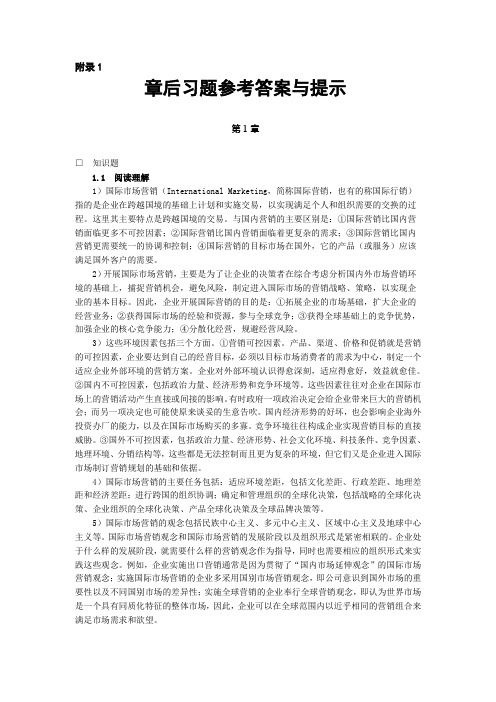
附录1章后习题参考答案与提示第1章□知识题1.1 阅读理解1)国际市场营销(International Marketing,简称国际营销,也有的称国际行销)指的是企业在跨越国境的基础上计划和实施交易,以实现满足个人和组织需要的交换的过程。
这里其主要特点是跨越国境的交易。
与国内营销的主要区别是:①国际营销比国内营销面临更多不可控因素;②国际营销比国内营销面临着更复杂的需求;③国际营销比国内营销更需要统一的协调和控制;④国际营销的目标市场在国外,它的产品(或服务)应该满足国外客户的需要。
2)开展国际市场营销,主要是为了让企业的决策者在综合考虑分析国内外市场营销环境的基础上,捕捉营销机会,避免风险,制定进入国际市场的营销战略、策略,以实现企业的基本目标。
因此,企业开展国际营销的目的是:①拓展企业的市场基础,扩大企业的经营业务;②获得国际市场的经验和资源,参与全球竞争;③获得全球基础上的竞争优势,加强企业的核心竞争能力;④分散化经营,规避经营风险。
3)这些环境因素包括三个方面。
①营销可控因素。
产品、渠道、价格和促销就是营销的可控因素,企业要达到自己的经营目标,必须以目标市场消费者的需求为中心,制定一个适应企业外部环境的营销方案。
企业对外部环境认识得愈深刻,适应得愈好,效益就愈佳。
②国内不可控因素,包括政治力量、经济形势和竞争环境等。
这些因素往往对企业在国际市场上的营销活动产生直接或间接的影响。
有时政府一项政治决定会给企业带来巨大的营销机会;而另一项决定也可能使原来谈妥的生意告吹。
国内经济形势的好坏,也会影响企业海外投资办厂的能力,以及在国际市场购买的多寡。
竞争环境往往构成企业实现营销目标的直接威胁。
③国外不可控因素,包括政治力量、经济形势、社会文化环境、科技条件、竞争因素、地理环境、分销结构等,这些都是无法控制而且更为复杂的环境,但它们又是企业进入国际市场制订营销规划的基础和依据。
4)国际市场营销的主要任务包括:适应环境差距,包括文化差距、行政差距、地理差距和经济差距;进行跨国的组织协调;确定和管理组织的全球化决策,包括战略的全球化决策、企业组织的全球化决策、产品全球化决策及全球品牌决策等。
国际市场营销 全球营销学每章课后习题答案
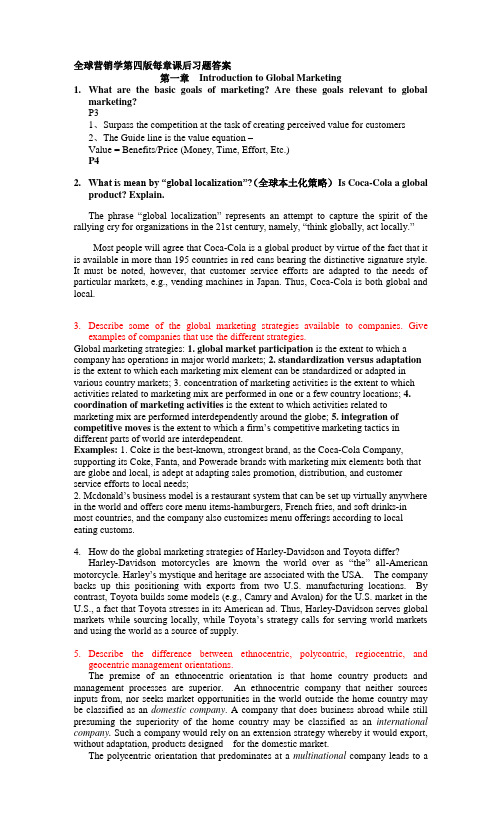
全球营销学第四版每章课后习题答案第一章Introduction to Global Marketing1.What are the basic goals of marketing? Are these goals relevant to globalmarketing?P31、Surpass the competition at the task of creating perceived value for customers2、The Guide line is the value equation –Value = Benefits/Price (Money, Time, Effort, Etc.)P42.What is mean by “global localization”?(全球本土化策略)Is Coca-Cola a globalproduct? Explain.The phrase “global localization” represents an attempt to capture the spirit of the rallying cry for o rganizations in the 21st century, namely, “think globally, act locally.”Most people will agree that Coca-Cola is a global product by virtue of the fact that it is available in more than 195 countries in red cans bearing the distinctive signature style. It must be noted, however, that customer service efforts are adapted to the needs of particular markets, e.g., vending machines in Japan. Thus, Coca-Cola is both global and local.3.Describe some of the global marketing strategies available to companies. Giveexamples of companies that use the different strategies.Global marketing strategies: 1. global market participation is the extent to which a company has operations in major world markets; 2. standardization versus adaptation is the extent to which each marketing mix element can be standardized or adapted in various country markets; 3. concentration of marketing activities is the extent to which activities related to marketing mix are performed in one or a few country locations; 4. coordination of marketing activities is the extent to which activities related to marketing mix are performed interdependently around the globe; 5. integration of competitive moves is the extent to which a firm’s competitive marketing tactics in different parts of world are interdependent.Examples: 1. Coke is the best-known, strongest brand, as the Coca-Cola Company, supporting its Coke, Fanta, and Powerade brands with marketing mix elements both that are globe and local, is adept at adapting sales promotion, distribution, and customer service efforts to local needs;2. Mcdonald’s business model is a restaurant system that can be set up virtually anywhere in the world and offers core menu items-hamburgers, French fries, and soft drinks-in most countries, and the company also customizes menu offerings according to local eating customs.4.How do the global marketing strategies of Harley-Davidson and Toyota differ?Harley-Davidson motorcycles are known the world over as “the” all-American motorcycle. Harley’s mystique and heritag e are associated with the USA. The company backs up this positioning with exports from two U.S. manufacturing locations. By contrast, Toyota builds some models (e.g., Camry and Avalon) for the U.S. market in the U.S., a fact that Toyota stresses in its American ad. Thus, Harley-Davidson serves global markets while sourcing locally, while Toyota’s strategy calls for serving world markets and using the world as a source of supply.5.Describe the difference between ethnocentric, polycontric, regiocentric, andgeocentric management orientations.The premise of an ethnocentric orientation is that home country products and management processes are superior. An ethnocentric company that neither sources inputs from, nor seeks market opportunities in the world outside the home country may be classified as an domestic company. A company that does business abroad while still presuming the superiority of the home country may be classified as an international company. Such a company would rely on an extension strategy whereby it would export, without adaptation, products designed for the domestic market.The polycentric orientation that predominates at a multinational company leads to aview of the world in which each country markets is different from the others. Local country managers operating with a high degree of autonomy adapt the marketing mix in a polycentric, multinational company. Managers who are regiocentric or geocentric in their orientations recognize both similarities and differences in world markets. Market opportunities are pursued using both extension and adaptation strategies. The regiocentric and geocentric orientations are characteristic of global transnational companies.OrEthnocentric orientation: home country is superior to the rest of the world, sees similarities in foreign countries,leads to a standardized or extension approach; Polycentric orientation: the opposite of ethnocentrism, each country in which a company does business is unique, sees differences in foreign countries, leads to localized or adaption approach; Regiocentric orientation: a region becomes the relevant geographic unit; management`s goal is to develop an integrated regional strategy; Geocentric orientation:views the entire world as a potential market and strives to develop integrated world market strategies.6.Identify and briefly describe some of the forces that have resulted in increased globalintegration and the growing importance of global marketing.P21+Driving Forces:Regional economic agreements、Market needs and wants、TechnologyTransportation and communication improvements、Product development costs、Quality、World economic trends、LeverageRestraining Forces:Management myopia、Organizational culture、National controls 7.Define leverage and explain the different types of leverage utilized by companieswith global operations.Define leverage:P25第二章The Global Economic Environment1.Explain the difference between market capitalism, centrally planned capitalism,centrally planned socialism, and market socialism. Give an example of a country that illustrates each types of system.Market capitalism is an economic system in which individuals and firms allocate resources and production resources are privately owned. (England).Centrally planned capitalism is an economic system in which command resource allocation is utilized extensively in an environment of private resource ownership. (Sweden)Centrally planned socialism, in this type of economic system, the state has broad powers to serve the public interest as it sees fit. (Former Soviet Union)Market socialism, in such a system, market allocation policies are permitted within an overall environment of state ownership. (China)2.What is a BEM? Identify the BEMs according to their respective stages of economicdevelopment.P53P56-583. A manufacture of satellite dishes is assessing the world market potential for hisproducts. He asks you if he should consider developing countries as potential markets.How would you advise him?Despite the difficult economic conditions in parts of developing countries, many nations will involve into attractive markets.One of marketing’s roles in developing countries is to focus resources on the task of creating and delivering products that are best suited to local needs and incomes. The role of marketing to indentify people’s needs and wants is the same in all countries, irrespective of level of economic development. It is also an opportunity to help developing countries join the information age.And P654.Turn to the Index of Economic Freedom (Table 2-1) and identify where the BEMs areranked. What does the result tell you in terms of the relevance of the index to global marketers?P52第三章Social and Cultural Environments1.What are some of the elements that make up culture? How do these find expression inyour native culture?Culture is a collection of Values, beliefs, behaviors, customs, and attitudes that distinguish one society from another.Culture is acted out in social institutions, such as, family, education, religion, government, business.2.What is the difference between a low-context culture and a high-context culture?Give an example of a country that is an example of each type and provide evidence for your answer.PPT 第四章4-63.How can Hofstede’s cultural typologies help Western marketers better understandAsian culture?P874.Explain the self-reference criterion(自我参照准则). Go to the library and findexamples of product failures that might have been avoided through the application of the SRC.Unconscious reference to one’s own cultural values; creates cultural myopia5.Briefly explain the social research of Everrtt Rogers regarding diffusion ofinnovations,……P94pare and contrast USA and Japan in terms of traditions and organizationalbehavior and norms.第四章The Legal and Regulatory Environments of Global Marketing1.What is sovereignty? What is it an important consideration in the politicalenvironment of global marketing?sovereignty2.Describe some of the sources of political risk. Specially, what forms can political risktake?Tension between aspirations and realityPrimarily occurs in lower and lower-middle income countries–Indonesia and economic crisisWhen political risk occurs in high income countries, it is generally due to a long-standing conflict–Northern IrelandP1423.Briefly describe some of the differences between the legal environment of a countrythat embraces common law and one that observes civil law.4.Global marketers can avoid legal conflicts by understanding the reasons conflictsarise in the first place. Identify and describe several legal issues that relate to global commerce.Intellectual PropertyAntitrustContractualLicensing and Trade Secrets5.“See you in court” is one way to respond when legal issues arise. What otherapproaches are possible?LitigationFormal arbitration–Settles disputes outside of court–Groups agree to abide by panel’s decision1958 United Nations Convention on the Recognition and Enforcement of Foreign Arbitral Awards–Most important treaty regarding international arbitration第五章Global Information Systems and Market Research1.Explain two information technology puts powerful tools in the hands of globalmarketers.Modern IT tools provide the means for a company's marketing information system and research functions to provide relevant information in a timely, cost –efficient, and actionable manner.Electronic data interchange (EDI) allows business units to submit orders, to issue invoices, to conduct business electronically, Wal-Mart legendary for its EDI, save time and money, enables retailers to improve inventory management. Transaction formats are universalEfficient Consumer Response (ECR) This is in addition to EDI, an effort for retailers and vendors to work closely on stock replenishment(补充). ECR can be defined as a joint initiative by members of a supply chain to work toward improving and optimizing(最优化) aspects of the supply chain to benefit customersIntranet, Electronic Point of Sale (EPOS), Data Warehouses are also helping businesses improve their ability to target consumers and increase loyalty.2.What are the different modes of information acquisition? Which is the most importantfor gathering strategic information?3.4、Outline the basic steps of the market research process.5、What is the difference between existing, latent, and incipient demand? How mightthese differences affect the design of a marketing research project?Demand and profit potential, in turn, depend in part on whether the market being studied can be classifieds existing or potential. Existing markets are those in which customer needs are already being served by one or more companies. In some instances, there is no existing market to research and. information may be readily available. A latent market is in essence, an und iscovered segment .It’s a market in which demand would materialize if an appropriate product were made available. An incipient market is a market that will emerge if particular economic demographic, political, or sociocultural trend continues. A company is not likely to achieve satisfactory results if it offers a product in an incipient market before the trends have taken root.Market growth, brand loyalty, market segment, product, sales promotion, pricing, distribution, will be different in marketing research project.6.Describe some of the analytical techniques used by global marketers. When is it appropriate to use each technique?A number of techniques are available for analyzing survey data.Factor analysis can be used to transform large amount of data into manageable units. It is useful in psychographic segmentation studies or creating perceptual maps; cluster analysis allows the researchers to group variables into clusters that maximize within-group similarities and between-group differences. It can be used to do global marketing research, to perform benefit segmentation, and to identify new product opportunities. Multi dimensional scaling is another technique for creating perceptual maps which is particular useful when there are many product to choose and consumers have difficulty in verbalizing their conceptions. Conjoint analysis is used to gain insights into the combination of features that will be the most attractive to consumers. It is useful when determines the values and utilities of the various levels of product features and plots them graphically.第六章Segmentation, Targeting, and Positioning1.differentiate the five basic segmentation strategies. Give an example of a companythat has used each one.P170-P1831、IncomePopulationsAge distributionGenderEducationOccupation2、Grouping people according to attitudes, value, and lifestyles3、4、Benefit segmentation focuses on the value equation–Value = Benefits / Price5、The population of many countries includes ethnic groups of significant size2.Explain the difference between segmenting and targeting.P200pare and contrast standardized, concentrated, and differentiated global marketing.Illustrate each strategy with an example from a global company.Standardized global marketing is mass marketing on a global scale with undifferentiated target marketing (Revlon International)Concentrated global marketing, involves devising a marketing mix to reach a niche. A niche is simply a single segment of the global market. (Germany`s Winter halter) Differentiated global marketing, represents a more ambitious approach than concentrated target marketing with multi-segment targeting and two or more distinct markets (Rover)4.5.What is positioning? Identify the different positioning strategies presented in thechapter and give examples of companies or products that illustrate each.Locating a brand in consumers’minds over and against competitors in terms of attributes and benefits that the brand does and does not offer.P192-1956.What is global consumer culture positioning? What other strategic positioningchoices do global marketers have?Identifies the brand as a symbol of a particular global culture or segment.P1967.What is high-touch product? Explain the difference between high-tech productpositioning and high-touch product positioning. Can some products be positioned using both strategies? Explain.High-tech products are sophisticated technologically complex, and/or difficult to explain or understand, and frequently evaluated in terms of their performance against established objective standards. High-tech global consumer positioning also works well for special interest products associated with leisure of recreation.High-touch products, consumers are generally energized by emotional motives rather than rational ones, and frequently evaluated in terms of their performance against established subjective, aesthetic terms.Some products can be positioned using both strategies, with both satisfying buyers’ rational criteria and evoking an emotional response. Nokia, for example, combines technical performance with a fashion orientation.第七章Global Market Entry Strategies:1.What are the advantages and disadvantages of using licensing as a market entry tool?Give examples of companies from different countries that use licensing as a global marketing strategy.Advantages to LicensingProvides additional profitability with little initial investmentProvides method of circumventing tariffs, quotas, and other export barriersAttractive ROILow costs to implementDisadvantages to LicensingLimited participationReturns may be lostLack of controlLicensee may become competitorLicensee may exploit company resourcesP2062.What is foreign direct investment? What forms can FDI take?P209Partial or full ownership of operations outside of home countryForms:Joint ventures–Minority or majority equity stakes–Outright acquisition3.Do you agree with Ford’s decision to acquire Jaguar? What was more valuable toFord---the physical assets or the name?P2154.What is meant by the phrase global strategic partnership? In what ways does this formof market entry strategy differ from more traditional forms such as joint ventures? Participants remain independent following formation of the allianceParticipants share benefits of alliance as well as control over performance of assigned tasksParticipants make ongoing contributions in technology, products, and other key strategic areasPPT3055.What are Keiretsu? How does this form of industrial structure affect companies thatcompete with Japan or that are trying to enter the Japanese market?PPT307书P2276.Which Strategic options for market entry or expansion would a small company belikely to pursue? A large company?StrategiesCompanies must decide to expand by:–Seeking new markets in existing countries–Seeking new country markets for already identified and served market segments第八章Product and Brand Decisions1.What is the difference between a product and a brand?A product is a good, service, or ideaBrandsBundle of images and experiences in the customer’s mindA promise made by a particular company about a particular productA quality certificationDifferentiation between competing productsThe sum of impressions about a brand is the Brand ImageThe added value that accrues to a product as a result of investments in the marketing of the brandAn asset that represents the value created by the relationship between the brand and customer over time2.How do local, international, and global products differ? Cite examplesLocal Product is one that has achieved success in a single national market and represents the lifeblood of domestic companies. (Coca-cola, ginseng beverage only in Japan)International product is offered in several markets in a particular region (Euro-product, only in euro zone)Global product meets the wants and needs of a global market and is offered in all world regions (personal stereos)3.What are some of the elements that make up a brand? Are these elements tangible orintangible?IntangibleP2414.What criteria should global marketers consider when making product designdecisions?In many instances, packaging is an integral element of product-related design decisions. Packaging is designed to protect or contain the product during shipping;Labeling provides consumers with various types of information; Aesthetics differ around the world. Global marketers must understand the importance of visual aesthetics; Product Warranties is a written guarantee that assures the buyer is getting what they paid for or provides a remedy in case of a product failure. Warranties can be used as a competitive tool5.How can buyer at titudes about a product’s country of origin affect marketing strategy?买家对于原产国的态度对营销策略有什么影响?Perceptions about and attitudes toward particular countries often extend to products and brands known to originate in those countries–Japan–Germany–France–ItalyP252-2546.Identify several global brands. What are some of the reasons for the global success ofthe brands you chose?Both products and brand are good……7.Briefly describe various combinations of product-communication strategies availableto global marketers. When is it appropriate to use each?Product-communication extension (dual extension) is a strategy selling the same product with the same promotional appeals used in domestically when pursuing opportunities outside the home market. It used frequently with industrial (business to business) products.Product extension-communication adaptation strategy is a relatively low cost of implementation because the physical product is unchanged, and the main costs are associated with market research and revising promotional appeals. It used frequently when consumer conceptions outside the home market are very different from domestic marketProduct adaptation-communication extension is an approach to global product planning is to extend, without change, the basic home-market communications strategy while adapting the product to local use or preference conditions. It used frequently when natural conditions outside the home market are very different from domestic market Product-communication adaptation (dual adaptation) strateg y is an approach used both the different product serves and advertising appeals to consumer receptivity when comparing a new geographic market to the home market, environmental conditions or consumer preferences differ;第九章Pricing Decisions1.What are the basic factors that affect price in any market? What considerations enterinto the pricing decision?In global marketing, the task of setting prices is complicated by fluctuating exchange rates. Currency fluctuations can create significant problems and opportunities for the classic international company that exports from the home country.Inflation, or a persistent upward change in price levels, is a problem in many country markets. It can be caused by an increase in the money supply and currency devaluation. Governmental policies and regulations that affect pricing decisions include dumping legislation, resale price maintenance legislation, price ceilings, and general reviews of price levels.Pricing decisions are bounded not only by cost and nature of demand but also by competitive action.Competitive Behavior: If competitors do not adjust their prices in response to rising costs it is difficult to adjust your price to maintain operating margins; If competitors are manufacturing or sourcing I a lower-cost country, it may be necessary to cut prices to stay competitiveThe global marketer has several options for addressing the problem of price escalation orthe environmental factors described in the last section.2.Define the various types of pricing strategies and objectives available to globalmarketers.Market Skimming and Financial Objectives: Market Skimming charges a premium price which may occur at the introduction stage of product life cyclePenetration Pricing and Non-Financial Objectives: Penetration Pricing charges a low price in order to penetrate market quickly which appropriates to saturate market prior to imitation by competitors3.Identify some of the environmental constraints on global pricing decisions. Currency FluctuationsInflationary EnvironmentGovernment Controls, Subsidies, RegulationsCompetitive BehaviorSourcing4.Why do price differences in world markets often lead to gray marketing?Because price differences in world markets lead to trademarked products are exported from one country to another where they are sold by unauthorized persons or organizationsGray marketing occurs when product is in short supply, when producers use skimming strategies in some markets, and when goods are subject to substantial mark-ups 5.What is dumping? Why was dumping such an important issue during the UruguayRound of GATT negotiations?Sale of an imported product at a price lower than that normally charged in a domestic market or country of origin.P2966.What is transfer price? Why is it an important issue for companies with foreignaffiliates(外国子公司)? Why did transfer pricing in Europe take on increased importance in 1999?The transfer price is that Pricing of goods, services, and intangible property bought and sold by operating units or divisions of a company doing business with an affiliate in another jurisdiction.P2997.What is the difference between ethnocentric, polycontric, and geocentric pricingstrategies? Which one would you recommend to a company that has global market aspirations?P291-292 PPT240-242pare and contrast the different forms of countertrade.Countertrade occurs when payment is made in some form other than moneyOptions–BarterThe least complex and oldest form of bilateral, non-monetary counter-tradeA direct exchange of goods or services between two parties–Counter-purchase P303-304–Offset–Compensation trading–Cooperation agreements–Switch trading第十章Global Marketing Channels and Physical Distribution1.In what ways can channel intermediaries create utility for buyers?ObjectivesMarketing channels exist to create utility for customers–Place utility -availability of a product or service in a location that is convenient to a potential customer–Time utility -availability of a product or service when desired by a customer–Form utility -availability of the product processed, prepared, in proper condition and/or ready to use–information utility -availability of answers to questions and general communicationabout useful product features and benefits2.What factors influence the channel structures and strategies available to globalmarketers?B2CThe characters of both buyers and products have an important influence on channel design.The number of individual buyers and their geographic distribution, income, shopping habits and different channel approaches.Products characters such as degree of standardization, perishability, bulk, service requirements, and unit price have an impact as well.Channels tends to be longer as the number of consumers to be served increases and the price per unit decreases. Bulky products usually require channel arrangements that minimize the shipping distances and the number of times products change hands before they reach the ultimate customer.B2BAs is true with consumer channels, product and consumer characteristics have an impact on channel structure. Three basic elements are involved: the manufacture's sales force, distributors or agents and wholesalers.Channel strategy in a global marketing program must fit the company's competitive position and overall marketing objectives in each national market.market factors: consumer profiles, market size and location of country.3.What is cherry picking? What approaches can be used to deal with this problem?P323pare and contrast the typical channel structures for consumer products andindustrial products.P340 PPT252-2555.Identify the different forms of retailing and cite an example of each form. Identifyretailers from as many different countries as you can.PPT258-259 P3256.Identify the four retail market expansion strategies discussed in the text. What factorsdetermine the appropriable mode?Organic–Company uses its own resources to open a store on a green field site or acquire one or more existing retail facilitiesFranchise–Appropriate strategy when barriers to entry are low yet the market is culturally distant in terms of consumer behavior or retailing structuresChain Acquisition–A market entry strategy that entails purchasing a company with multiple existing outlets in a foreign countryJoint Venture–This strategy is advisable when culturally distant, difficult-to-enter markets are targeted 7.What special distribution challenges exist in Japan? What is the best way for anon-Japanese company to deal with these challenges?第十一章Global Marketing Communications Decisions:Advertising and Public Relations1.In what ways can global brands and global advertising campaigns benefit a company? P3482.How does the “standardized versus localized” debate apply to advertising?Four difficulties that compromise an organization’s communicat ion efforts–The message may not get through to the intended recipient.–The message may reach the target audience but may not be understood or may even be misunderstood.–The message may reach the target audience and may be understood but still may not induce the recipient to take the action desired by the sender.–The effectiveness of the message can be impaired by noise.。
国际市场营销(第十六版)参考答案
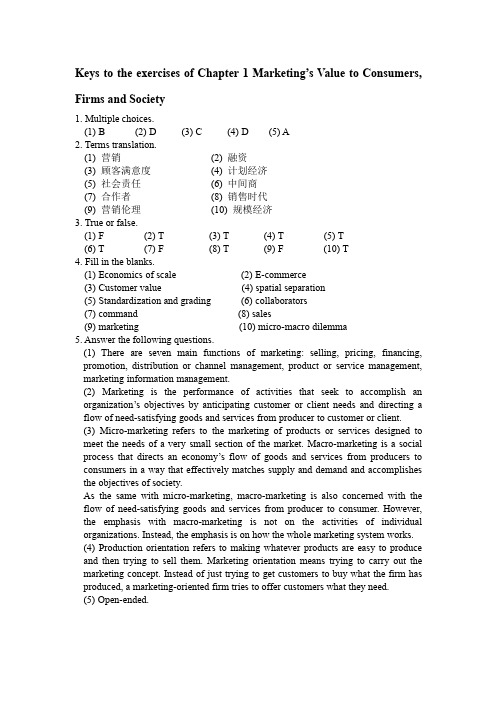
Keys to the exercises of Chapter1Marketing’s Value to Consumers, Firms and Society1.Multiple choices.(1)B(2)D(3)C(4)D(5)A2.Terms translation.(1)营销(2)融资(3)顾客满意度(4)计划经济(5)社会责任(6)中间商(7)合作者(8)销售时代(9)营销伦理(10)规模经济3.True or false.(1)F(2)T(3)T(4)T(5)T(6)T(7)F(8)T(9)F(10)T4.Fill in the blanks.(1)Economics of scale(2)E-commerce(3)Customer value(4)spatial separation(5)Standardization and grading(6)collaborators(7)command(8)sales(9)marketing(10)micro-macro dilemma5.Answer the following questions.(1)There are seven main functions of marketing:selling,pricing,financing, promotion,distribution or channel management,product or service management, marketing information management.(2)Marketing is the performance of activities that seek to accomplish an organization’s objectives by anticipating customer or client needs and directing a flow of need-satisfying goods and services from producer to customer or client. (3)Micro-marketing refers to the marketing of products or services designed to meet the needs of a very small section of the market.Macro-marketing is a social process that directs an economy’s flow of goods and services from producers to consumers in a way that effectively matches supply and demand and accomplishes the objectives of society.As the same with micro-marketing,macro-marketing is also concerned with the flow of need-satisfying goods and services from producer to consumer.However, the emphasis with macro-marketing is not on the activities of individual organizations.Instead,the emphasis is on how the whole marketing system works.(4)Production orientation refers to making whatever products are easy to produce and then trying to sell them.Marketing orientation means trying to carry out the marketing concept.Instead of just trying to get customers to buy what the firm has produced,a marketing-oriented firm tries to offer customers what they need. (5)Open-ended.Keys to the exercises of Chapter2:Evaluating Opportunities in theChanging Market Environment1.Multiple choices(1)C(2)B(3)D(4)B(5)A2.Terms translation(1)公司宗旨(2)竞争环境(3)可持续的竞争优势(4)竞争对手分析(5)经济环境(6)文化和社会环境(7)国民总收入(GNI)(8)智能代理(9)民族主义(10)可持续性3.True or false(1)T(2)T(3)F(4)F(5)T(6)F(7)T(8)T(9)F(10)T4.Fill in the blanks(1)mission statement(2)monopoly(3)opportunities(4)Artificial intelligence(AI)(5)intelligent agent(6)Nationalism(7)Free trade(8)competition(9)return on investment(10)Sustainability 5.Answer the following questions(1)The marketing manager should be heard when the company is setting objectives. But setting whole-company objectives—within resource limits—ultimately is the responsibility of top management.Top management must look at the whole business, relate its present objectives and resources to the external environment,and then decide what the firm wants to accomplish in the future.(2)Many firms try to avoid this problem by developing a mission statement,which sets out the organization’s basic purpose for being.A good mission statement focuses on a few key goals rather than embracing everything.It should guide managers in determining which opportunities to pursue.(3)To find its strengths or recognize weaknesses,a firm must evaluate its functional areas(production,research and engineering,marketing,general management,and finance)as well as its present products and markets.(4)Sustainable competitive advantage refers to a marketing mix that customers see as better than a competitor’s mix and cannot be quickly or easily copied.The search for some sort of competitive advantage—requires an understanding not only of customers but also of competitors.That’s why marketing managers turn to competitor analysis—an organized approach for evaluating the strengths and weaknesses of current or potential competitors’marketing strategies.(5)open-ended.Key to the exercises of Chapter3Focusing marketing strategy with segmentation and positioning1.Multiple choices.(1)A(2)D(3)D(4)C(5)C2.Terms translation.(1)市场细分(2)子市场,次市场(3)定位(4)客户关系管理(5)产品市场(6)差异化(7)定位声明(8)一般市场(9)组合(10)品牌熟悉度3.True or false.(1)F(2)T(3)F(4)F(5)F(6)T(7)T(8)T(9)T(10)F4.Fill in the blanks.(1)Submarkets(2)heterogeneous(3)Clustering(4)Segmenters(5)generic(6)Market segmentation(7)naming segmenting(8)Qualifying(9)Determining(10)Positioning5.Answer the following questions(1)A generic market is a market with broadly similar needs and sellers offering various,often diverse,ways of satisfying those needs.A product-market is a market with very similar needs and seller offering various close substitute ways of satisfying those needs.(2)Market segmentation is a two-step process of①naming broad product-markets and②segmenting these broad product-markets in order to select target markets and develop suitable marketing mixes.(3)There are three basic ways to develop market-oriented strategies in a broad product-market.①The single target market approach—segmenting the market and picking one of the homogeneous segments as the firm’s target market.②The multiple target market approach—segmenting the market and choosing two or more segments,and then treating each as a separate target market needing a different marketing mix.③The combined target market approach—combing two or more submarkets into one larger target market as a basis for one strategy.④Kind of relationship,types of customer,geographic,demographic,how product will be used,type of buying situation,purchasing methods.(5)A positioning analysis helps managers understand how customers see their market.It is a visual aid to understanding a product-market.The first time such an analysis is done,managers may be shocked to see how much customers’perceptions of a market differ from their own.Keys to the exercises of Chapter 4:1.Multiple choices (1)B (2)C (3)D (4)A (5)B2.Terms translation(1)消费者购买行为(2)经济需求(3)需求层次(4)空巢家庭(5)参照群体(6)安全需求(7)选择性记忆(8)生理需求(9)可支配收入(10)强化3.True or false (1)T (2)T (3)F (4)T (5)F (6)T (7)T (8)F (9)F (10)T4.Fill in the blanks (1)Learning (2)opinion (3)stimuli (4)Consumer (5)Social (6)classes (7)family (8)attitude (9)psychological (10)Perception5.Answer the following questions.(1)Needs are the basic forces that motivates a person to do something.Wants are “needs”that are learned during a person’s life.A drive is a strong stimulus that encourages action to reduce a need.(2)Maslow is well known for his five-level hierarchy of needs.They are physiological needs,safety needs,social needs,esteem needs and self-actualization.Esteem needs and self-actualization can be simplified as personal needs.(3)The learning process are illustrated as following.(4)Young single,young married without children,young married with children,middle-aged married with children,middle-aged married without dependent children,older married,and widowed.(5)Consumers use extensive problem solving when they put much effort into deciding how to satisfy a need.Limited problem solving is used by consumers when some effort is required in deciding the best way to satisfy a need.A consumer uses routinized response behavior when he or she regularly selects a CuesDriveResponse Reinforcementparticular way of satisfying a need when it occurs.Key to the exercises of Chapter51.Multiple choices(1)C(2)B(3)B(4)D(5)A2.Terms translation(1)企业顾客(2)组织买家(3)采购中心(4)首次购买(5)采购经理(6)供货商分析(7)直接再购(8)外包(9)购买申请(10)竞标3.True or false(1)F(2)F(3)F(4)T(5)T(6)T(7)F(8)T(9)F(10)T4.Fill in the blanks(1)derived(2)straight rebuy(3)fewer,emotional(4)New-task(5) local(6)Negotiated(7)buying center(8)dispersed(9)purchasing(10) deciders5.Answer the following questions.(1)Manufacturers;producers of services;retailers and wholesalers;government units(2)Users;influencers;buyers;deciders;gatekeepers(3)A straight rebuy is a routine repurchase that may have been made many times before.A modified rebuy is the in-between process where some review of the buying situation is done—though not as much as in new-task buying.(4)NAICS refers to North American Industry Classification System which are groupsof firms in similar lines of business.(5)Salespeople,others from supplier firms,trade shows,buying center members,outside business associates,consultants and outside expertsKeys to the exercises of CHAPTER61.Multiple choices(1)C(2)B(3)C(4)B(5)C2.Terms translation(1)物流系统(2)实体物流(3)顾客服务层次(4)供应链(5)电子数据交换(6)集装箱化(7)公营仓库(8)私营仓库(9)存货(10)运输方式3.True or false(1)T(2)F(3)T(4)T(5)F(6)T(7)T(8)F(9)T(10)F4.Fill in the blanks(1)logistics(2)trade-offs(3)chain(4)economies(5)valuable(6)carloads(7)distances(8)slowest(9)nonperishable(10)Pipelines5.Answer the following questionsAnswers are open for discussion.Keys to Chapter7Retailers,Wholesalers,and Their Strategy Planning1.Multiple choices(1)C(2)A(3)B(4)A(5)C2.Terms translation(1)专业商店(2)大众营销概念(3)折扣商店(4)量贩零售商(5)零售轮转理论(6)特许经营(7)专门批发商(8)产销直达货运批发商(9)制造商代理人(10)经纪人3.True or false(1)T(2)F(3)T(4)T(5)F(6)F(7)F(8)T(9)F(10)T4.Fill in the blanks(1)Single-line(2)specialty shop(3)Automatic vending(4)door-to-door(5)franchise operation(6)Wholesaling(7)Service wholesalers(8)Drop-shippers(9)Brokers(10)selling agent5.Answer the following questions(1)A specialty shop—a type of conventional limited-line store—is usually small and has a distinct personality.Specialty shops sell special types of shopping products, such as high-quality sporting goods,exclusive clothing,baked goods,or even antiques. Catering to certain types of customers whom the management and salespeople know well simplifies buying,speeds turnover,and cuts costs due to obsolescence and style changes.Specialty shops probably will continue to be a part of the retailing scene as long as customers have varied tastes and the money to satisfy them.(2)a.Internet retail is still growing.b.Online buying is more or less convenient.c.Online buying gets good information.d.The online costs for retailers and customers could be higher or lower.(3)The main advantage of limited-line retailers is that they can satisfy some target market better.Perhaps some are just more conveniently located.But most adjust tosuit specific customers.They build a relationship with their customers andearn a position as the place to shop for a certain type of product.But these retailers face the costly problem of havingto stock some slow-moving items in order to satisfy their target markets.Many of these stores are small—with high expenses relative to sales.(4)A manufacturers’agent sells similar products for several noncompeting producers—for a commission on what is actually sold.Such agents work almost as members of each company’s sales force,but they’re really independent wholesalers. More than half of all agent wholesalers are manufacturers’agents.Their big plus is that they already call on some customers and can add another product line at relatively low cost—and at no cost to the producer until something sells!If an area’s sales potential is low,a company may use a manufacturers’agent because the agent can do the job at low cost.Manufacturers’reps will continue to play an important role in businesses that need an agent to perform order-getting tasks.But manufacturers’reps everywhere are feeling pressure when it comes to routine business contacts.More producers are turning to telephone selling,websites,email, teleconferencing,and faxes to contact customers directly.(5)a.Wholesaling is in decline.b.Opportunities remain for progressive wholesalers.Those that have survived are adapting their marketing strategies and finding new ways to add value in the channel. Progressive wholesalers are becoming more concerned with their customers and with channel systems.c.Wholesalers need to add value.Progressive wholesalers need to be efficient,but that doesn’t mean they all have low costs.Keys to the CHAPTER81.Multiple choices(1)A(2)B(3)D(4)A(5)D2.Terms translation(1)促销(2)宣传(3)促销(4)公共关系(5)整合营销传播(6)AIDA模式(7)编码(8)信息通道(9)采用曲线(10)基本需求3.True or False(1)F(2)F(3)F(4)T(5)F(6)T(7)T(8)F(9)T(10)T4.Fill in blanks(1)seller(2)Pulling(3)adoption curve(4)innovators(5)early majority(6)selective demand(7)task method(8)Promotion(9)Mass selling(10)reminding5.Answer the following questions(1)a.Sale managers manage salespeople.b.Advertising managers work with ads and agencies.c.Sales promotion managers need many talents.They manage their company’s sales promotion effort.d.The marketing manager talks to all and blends all.They must weigh the pros and cons of the various promotion methods and then devise an effective promotion blend.(2)rming,persuading and reminding are basic promotion objectives.rming is educating.c.Persuading usually becomes necessary.d.Reminding may be enough sometimes.e.Promotion objectives relate to adoption process.(3)The basic promotion objectives and adoption process fit very neatly with another action-oriented model—called AIDA.It consists of four promotion jobs:1)to get attention,2)to hold interest,3)to arouse desire,and4)to obtain action.Getting attention is necessary to make consumers aware of the company’s offering. Holding interest gives the communication a chance to build the consumer’s interest in the product.Arousing desire affects the evaluation process,perhaps building preference.And obtaining action includes gaining trial,which may lead to a purchase decision.(4)a.During market introduction,the basic promotion objective is informing.b.In the market growth stage,more competitors enter the market,and promotion emphasis shifts from building primary demand to stimulating selective demand.c.In the market maturity stage,mass selling and sales promotion may dominate the promotion blends of consumer products firms.d.During the sales decline stage,the total amount spent on promotion usually decreases as firms try to cut costs to remain profitable.(5)The most common method of budgeting for promotion expenditures is to computea percentage of either past sales or sales expected in the future.The virtue of this method is its simplicity.In the light of our continuing focus on planning marketing strategies to reach objectives,the most sensible approach to budgeting promotion expenditures is the task method—basing the budget on the job to be done.It helps you to get priorities so that the money you spend produces specific results.Keys to CHAPTER91.Multiple choices(1)B(2)D(3)C(4)A(5)B2.Terms translation(1)目标利润目标(2)一种价格政策(3)渗透定价政策(4)基本价格表(5)折让(6)数量折扣(7)旧货折让折扣(8)给推销员的佣金(9)优惠券(10)广告补贴3.True or false(1)T(2)F(3)T(4)F(5)T(6)T(7)T(8)F(9)F(10)T4.Fill in the blanks(1)the Price(2)customer value(3)market share(4)Flexible pricing(5)Cumulative discounts(6)coupons(7)Rebate(8)monopolistic(9)Dumping(10)price discrimination5.Answer the following questions(1)a.Target returns provide specific guidelines.Marketing managers should set objectives oriented toward making a profit.A target objective sets a specific level of profit as an objective.Often this amount is stated as a percentage of sales or of capital investment.A target return objective has administrative advantages in a large company.Performance can be compared against the target.Some companies eliminate divisions, or drop products,that aren’t yielding the target rate of return.b.Some just want satisfactory profits.Some managers aim for only satisfactory returns.They just want returns that ensure the firm’s survival and convince stockholders they’re doing a good job.Many private and public nonprofit organizations set a price level that will just recover costs.In other words,their target return figure is zero.c.Profit maximization can be socially responsible.A profit maximization objective seeks to get as much profit as possible.It might be stated as a desire to earn a rapid return on investment or to charge all the traffic will bear.Pricing to achieve profit maximization doesn’t always lead to high prices.Low prices may expand the size of the market and result in greater sales and profits.(2)Marketing managers who administer prices must consciously set a price-level policy.As they enter the market,they have to set introductory prices that may have long-run effects.Marketers often use introductory price dealing—temporaryprice cuts—to speed products into a market and get customers to try them.The aim is to raise prices as soon as the introductory offer is over.By then,hopefully,target customers will have decided it is worth buying again at the regular price.Introductory price dealing should be part of a larger marketing strategy.(3)Cash discounts are reductions in price to encourage buyers to pay their bills quickly.The terms for a cash discount usually modify the net terms.Smart buyers carefully evaluate cash discounts.A discount of2/10,net30may not look like much at first.But the buyer earns a2percent discount for paying the invoice just20days sooner than it should be paid anyway.By not taking the discount,the company in effect is borrowing at an annual rate of36percent.That is,assuming a360-day year and dividing by20days,there are18periods during which the company could earn2 percent—and18times2equals36percent a year.(4)Allowances,like discounts,are given to final consumers,business customers,or channel members for doing something or accepting less of something.a.Advertising allowances are price reductions given to firms in the channel to encourage them to advertise or otherwise promote the supplier’s products locally.b.Stocking allowances,sometimes called slotting allowances,are given to an intermediary to get shelf space for a product.c.PMs,push money,or prize money allowances,sometimes called PMs or spiffs,are given to retailers by manufacturers or wholesalers to pass on to the retailers’salesclerks for aggressively selling certain items.d.A trade-in allowance is a price reduction given for used products when similar new products are bought.Trade-ins give the marketing manager an easy way to lower the effective price without reducing list price.(5)To maintain competition,there are several important regulations in the pricing area.Firstly,you can’t lie about prices.Phony list prices are prices customers are shown to suggest that the price has been discounted from the list.Most businesses,trade associations,and government agencies consider the use of phony list prices unethical.Secondly,pricing fixing is illegal.Price fixing,competitors getting together to raise, lower,or stabilize prices,is common and relatively easy.But it is also completely illegal in the United States.To discourage price fixing,both companies and individual managers are held responsible.Thirdly,producers may set minimum retail prices.Manufactures usually suggest a retail list price and then leave it up to retailers to decide what to charge in their local markets.Fourthly,U.S.antimonopoly laws ban price discrimination unless they are based on cost differences or the need to meet competition.Keys to the exercises of Chapter10:Ethical Marketing in a Consumer-Oriented World:Appraisal and Challenges1.Multiple choices(1)D(2)B(3)A(4)B(5)C2.True or false(1)F(2)F(3)T(4)T(5)F(6)F(7)T(8)F(9)T(10)T3.Fill in the blanks(1)attitude research studies(2)Micro-marketing;macro-marketing(3)consumer(4)society(5)marketing(6)increase(7)lower(8)materialistic(9)social values(10)actual performance4.Answer the following questions(1)open-ended.(2)ck of interest in or understanding of the sometimes fickle customer.b.Improper blending of the Four Ps—lack of understanding of or adjustment to the market environment,especially what competitors do.(3)Too many managers seize on whatever strategy seems easiest rather than seeking really new ways to satisfy customers.Too many companies stifle really innovative yers of bureaucracy and a“that’s not the way we do things”mentality can snuff it out.On the other hand,not every new idea is a good idea for every company.Many firms have lost millions of dollars with failed efforts to jump on the“what’s new”bandwagon—without stopping to figure out how it is going to really satisfy the customer and result in profit for the firm.(4)It seems fair to suggest that marketing managers should be expected to improve and expand the range of goods and services they make available—always trying to add value and better satisfy consumers’needs and preferences.This is the job we’ve assigned to business.If pursuing this objective makes excessive demands on scarce resources or has an unacceptable ecological effect,then consumer-citizens have the responsibility to vote for laws restricting individual firms that are trying to satisfy consumers’needs.This is the role that we,as consumers,have assigned to the government—to ensure that the macro-marketing system works effectively.(5)open-ended.。
国际市场营销学习题及答案
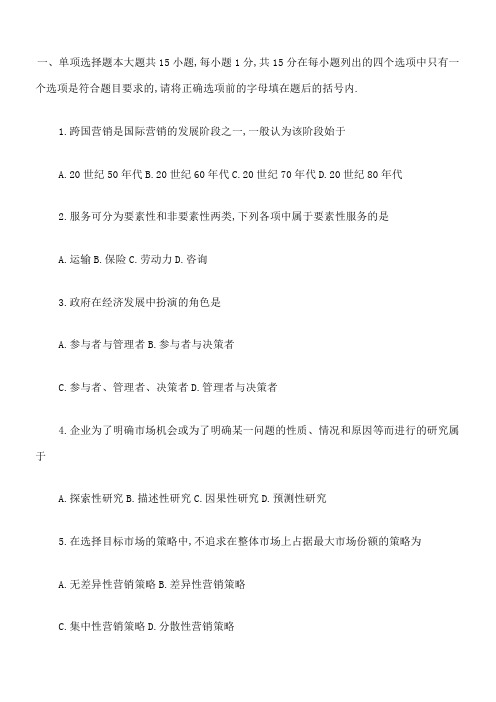
一、单项选择题本大题共15小题,每小题1分,共15分在每小题列出的四个选项中只有一个选项是符合题目要求的,请将正确选项前的字母填在题后的括号内.1.跨国营销是国际营销的发展阶段之一,一般认为该阶段始于A.20世纪50年代B.20世纪60年代C.20世纪70年代D.20世纪80年代2.服务可分为要素性和非要素性两类,下列各项中属于要素性服务的是A.运输B.保险C.劳动力D.咨询3.政府在经济发展中扮演的角色是A.参与者与管理者B.参与者与决策者C.参与者、管理者、决策者D.管理者与决策者4.企业为了明确市场机会或为了明确某一问题的性质、情况和原因等而进行的研究属于A.探索性研究B.描述性研究C.因果性研究D.预测性研究5.在选择目标市场的策略中,不追求在整体市场上占据最大市场份额的策略为A.无差异性营销策略B.差异性营销策略C.集中性营销策略D.分散性营销策略6.在产品生命周期各阶段中,企业需要侧重于加强成本和质量控制,增强、维护产品和商标信誉的阶段是A.投入期B.成长期C.成熟期D.衰退期7.在波士顿矩阵分析法中,销量增长快、市场占有率低的产品称为A.金牛产品B.明星产品C.问题产品D.瘦狗产品8.企业在选择服务水平时,除了服务水平的适应性外,还要考虑的一个因素是服务水平的A.经济性B.选择性C.独创性D.竞争性9.在国际市场进入模式中,以"新产品-新需求-国际市场"为基本格局的是A.市场渗透型模式B.产品开发型模式C.市场开发型模式D.多种经营型模式10.按国际上的通常定义,下列项目中不属于服务产品的是A.保险B.运输C.旅游D.技术专利11.在商品价格构成要素中,最基本、最主要的因素是A.价值B.成本C.利润D.边际效用12.收购和创建是跨国公司对外投资的两种方式,与收购相比,创建这种方式的优点是A.有利于迅速进入市场B.有利于扩大经营范围C.有利于管理D.失败率低13.企业的定价目标的基本类型有A.利润目标、竞争目标、发展目标B.利润目标、市场目标、竞争目标C.利润目标、市场目标、发展目标D.利润目标、市场目标、发展目标14.国际促销的实质是信息沟通的过程,在这个过程中,接收和理解信息的环节是A.编码B.信息渠道C.解码D.反馈15.国内出口中间商类型很多、特点各异,其中不拥有产品所有权的出口中间商是A.国际贸易公司B.出口直运批发商C.出口经营商D.国外设在本国的常驻采购商二、多项选择题本大题共10小题,每小题2分,共20分在每小题列出的五个选项中有二至五个选项是符合题目要求的,请将正确选项前的字母填在题后的括号内.多选、少选、错选均无分.16.国际营销的特殊性主要表现在A.竞争激烈B.经营复杂C.手段多变D.风险及难度大E.利润高17.出口控制的类型有A.出口国控制B.出口产品控制C.出口价值控制D.出口价格控制E.出口品牌控制18.国际营销的法律环境包括A.企业所在国的法律B.东道国的法律C.企业内部规章制度D.国际协议和国际组织E.合同19.国际市场微观细分的要求是A.可衡量性B.可接近性C.稳定性D.足量性E.可实施性20.产品组合一致性是指各产品线在下列哪些方面的相似或相近程度A.最终用途B.目标市场C.分销渠道D.工艺与原料E.成本与价格21.新产品战略的一般模式有A.保持地位战略B.革新战略C.放弃战略D.冒险战略E.多元化战略22.许可贸易是国际技术产品营销的重要形式,把许可协议分为独占许可协议、排它许可协议的依据是A.使用技术的地域范围B.使用权的大小C.使用费的高低D.使用时间的长短E.使用技术含量的多少23.在决定和影响跨国公司内部贸易发展的主要因素有A.节约市场交易成本B.增加营销措施C.在世界范围内利用资源禀赋优势D.保护技术秘密E.调整公司资源配置24.国际促销组合的四种主要方式是A.人员推销B.广告C.公共关系D.营业推广E.展览会25.在国际市场营销中,企业通常采用的定价方法主要有A.成本导向定价B.行为导向定价C.需求导向定价D.心理导向定价E.竞争导向定价第二部分非选择题三、名词解释题本大题共3小题,每小题4分,共12分26.国际市场营销研究27.补偿贸易28.转移价格四、简答题本大题共4小题,每小题6分,共24分29.国际市场营销战略规划的主要步骤是什么30.新产品开发的基本程序是什么31.直接出口方式的优点是什么32.简述国际营销文化环境的构成要素.五、案例题本大题共8分33.阅读下列资料,回答文后所列的问题.睡衣风波1997年美国和加拿大之间围绕"古巴睡衣"问题发生了一场政治纷争,而夹在两者之间的是一家百货业的跨国公司——沃尔-马特公司.当时,争执的激烈程度可以从下面的报纸新闻标题中见得一斑:"将古巴睡衣从加拿大货架撤下:沃尔-马特公司引起纷争"、"古巴问题:沃尔-马特公司因撤下睡衣而陷入困境"、"睡衣赌局:加拿大与美国赌外交"、"沃尔-马特公司将古巴睡衣放回货架."这一争端是由美国对古巴的禁运引起的.美国禁止其公司与古巴进行贸易往来,但在加拿大的美国公司是否也应执行禁运呢当时,沃尔-马特加拿大分公司采购了一批古巴生产的睡衣,美国总部的官员意识到此批睡衣的原产地是古巴后,便发出指令要求撤下所有古巴生产的睡衣,因为那样做违反了美赫尔姆斯——伯顿法.这一法律禁止美国公司及其在国外的子公司与古巴通商.而加拿大则是因美国法律对其主权的侵犯而恼怒,他们认为加拿大人有权决定是否购买古巴生产的睡衣.这样,沃尔-马特公司便成了加、美对外政策冲突的牺牲品.沃尔-马特在加拿大的公司如果继续销售那些睡衣,则会因违反美国法律而被处以100万美元的罚款.且还可能会因此而被判刑.但是,如果按其母公司的指示将加拿大商店中的睡衣撤回,按照加拿大法律,会被处以120万美元的罚款.问题:1造成沃尔-马特公司困难处境的原因是什么4分2结合案例说明政治环境与法律环境之间的关系.4分六、计算题本大题共8分34.某企业生产出口产品,年固定成本2000000元,每件产品的变动成本为10元,投资收益率为20%,若国际市场定货量是50000件,该产品出厂价格应为多少七、论述题本大题共13分35.结合当前实际谈谈我国企业发展跨国经营的必要性.一、单项选择题本大题共15题,每小题1分,共15分1.C2.C3.A4.A5.C6.C7.C8.A9.D10.D11.B12.D13.B14.C15.C二、多项选择题本大题共10小题,每小题2分,共20分16.ABCD17.ABD18.ABD19.ABDE20.ABCD21.ABD22.AB23.ACDE24.ABCD25.ACDE三、名词解释题本大题共3小题,每小题4分,共12分26.是国际市场营销的一项重要职能,它的任务是有系统、有目的地开发、整理与分析有关国际市场营销方面的信息,提供企业作决策依据.27.是技术输出方向技术输入方提供制造某种产品的技术、机器设备、原材料或零部件、技术服务,在一段时间内,则输入方用进口技术和设备生产的产品或所得的收益偿付输出方的技术与设备价款的贸易方式.28.是指同一跨国公司组织系统内母公司与子公司之间、子公司或分公司彼此之间进行内部交易时采用的价格.四、简答题本大题4小题,每小题6分,共24分29.环境分析;确定目标;确定营销战略与目标市场;确定财务预算;市场营销组合的确定与管理;评价与控制.30.确定新产品战略;新产品组织;新产品构思;新产品评价;新产品的商业化.31.销售及时;节约费用;加强推销;提供服务;控制价格;了解市场.32.物质文化;语言;教育;宗教;价值观和态度;社会组织.五、案例分析题8分33.1是由于东道国加拿大和母国美国政治和法律环境的冲突造成的.2法律环境是由政治环境衍生而来的,国际营销人员应当结合政治环境研究法律环境.六、计算题8分34.目标利润下单位产品价格=总固定成本+单位变动成本×销量+目标利润/销量目标利润=2000000+50000×10×20%=500000元该产品的出厂价格=2000000+10×50000+500000/50000=60元七、论述题13分35.1跨国经营已成为当代国际竞争与合作的重要方式.2是当代科技革命深入发展的客观要求.3地区集团化与贸易保护主义的挑战.4服务产业的国际化发展.5结合我国即将加入WTO的实际加以阐述单项选择题1 、“酒香不怕巷子深”是一种观念.A 、生产B 、产品 C、推销 D 、社会营销2 、生产观念强调的是.A 、以量取胜B 、以廉取胜 C、以质取胜 D 、以形象取胜3 、动机是以注重产品的实际使用价值为主要特征的.A 、求实B 、求名 C、求新 D 、求美4 、型购买行为发生在购买差异性不大的产品的场合.A 、复杂B 、多变 C、习惯 D 、和谐5 、改变消费者对竞争品牌的信念,这是定位.A 、实际的重新B 、心理的重新 C、竞争性反 D 、二次6 、下列组织中, b 不是营销中介单位.A 、中间商B 、供应商 C、银行 D 、保险公司7 、能满足同一需要的各种产品的生产者互为竞争者.A 、愿望B 、平行 C、产品形式 D 、品牌8 、当家庭收入达到一定水平时,随着收入增长,思格尔系数将.A 、下降B 、增大 C、不变 D 、上下波动9 、企业决定生产各种产品,但只向某一顾客群供应,这是.A 、产品/ 市场集中化B 、产品专业化C 、市场专业化 D、有选择专业化10、按照人口的具体变量细分市场的方法就是细分.A 、地理B 、行为 C、心理 D 、人口11、处于的产品,可采用无差异性的目标市场营销策略.A 、成长期B 、衰退期 C、导入期 D 、成熟期12、调查是为了解市场中出现的有关现象之间的因果关系而进行的专题调查.A 、探测性B 、描述性 C、因果性 D 、预测性13、以现有产品开发新市场,这是战略.A 、一体化B 、市场渗透 C、市场开发 D 、产品开发14、利用原有市场,采用不同技术开发新产品,这是战略.A 、产品开发B 、同心多元化 C、综合多元化 D 、水平多元化15、产业用品渠道一般不包括A 、批发商B 、代理商 C、制造商 D 、零售商16、产品价格低,其营销渠道就应.A 、长而窄B 、长而宽 C、短而窄 D 、短而宽17、生产者在某一地区仅通过少数几个精心挑选的中间商来分销产品,这是分销策略.A 、广泛B 、密集 C、强力 D 、选择性18、下列各项中, 不属于产品整体范畴.A 、品牌B 、包装 C、价格 D 、运送19、对现有产品的品质、款式、特点或包装等作一定的改进而形成的新产品,就是新产品.A 、仿制B 、改进 C、换代 D 、完全20、品牌中可以用语言称呼、表达的部分是.A 、品牌B 、商标 C、品牌标志 D 、品牌名称21、品牌就是指一个企业的各种产品分别采用不同的品牌.A 、个别B 、制造商 C、中间商 D 、统一22、在成本费用核算中,总成本费用与总产量之比称为.A 、边际成本B 、平均成本 C、平均固定成本 D、平均变动成本23、若EP ,则降价可扩大产品销售,增加盈利.A 、等于0B 、等于1C 、小于1D 、大于124、在投标定价中,应以时的价格为最佳报价.A 、成本最低B 、目标利润最高 C、中标概率最大 D、预期利润最大25、在衰退期,可采用定价的方法.A 、撇脂B 、渗透 C、驱逐 D 、满意26、工业产品的促销一般多采用的方法.A 、营业推广B 、人员推销 C、公关 D 、广告27、推销结构规定每一个推销员专门负责某一地区的推销.A 、区域B 、产品 C、顾客 D 、复式28、是立足于国内生产的国际营销方式.A 、许可证贸易 B、国际合资经营 C 、在国外装配生产 D、间接出口29、型组织就是在一名总产品经理领导下,再按每个品种分别设一名产品经理,实行分层管理的组织型式.A 、职能B 、地区 C、产品管理 D 、市场管理30、市场的需求具有鲜明的可诱导性.A 、产业B 、中间商 C、政府 D 、消费者多项选择题1 、一个国家的市场营销系统包括等流程.A 、资源B 、人员C 、货物和劳务D 、信息 E、货币2 、是市场导向的市场营销观念.A 、生产观念B 、产品观念C 、推销观念D 、市场营销观念 E、社会营销观念3 、影响消费者购买行为的心理因素包括.A 、需要和动机B 、感觉和知觉 C、学习和态度 D 、教育程度 E、记忆4 、消费者的信息主要有等几个方面的来源.A 、商业B 、间接 C、个人 D 、大众 E 、经验5 、产业用户购买中心是由等人员组成.A 、实际使用者B 、影响者 C、采购者 D 、决定者 E、信息控制者6 、分析营销环境的根本目的是.A 、扩大销售 B、对抗竞争 C、寻求营销机会 D、避免环境威胁 E、树立企业形象7 、社会购买力受到等因素的影响.A 、居民收入B 、币值 C、消费者储蓄 D、消费者信贷 E、消费者支出模式8 、政治法律环境是由那些影响各种组织、个人行为的组成.A 、法律B 、政府机构 C、群体规范 D、传统习惯 E、公众团体9 、市场细分的有效条件是.A 、可衡量性 B、可进入性 C、可获利性 D、长期稳定性 E、全面、综合性10、营销战略任务的确定应考虑等因素.A 、企业历史上的突出特征 B、环境变化 C、企业资源 D、企业的特有能力E 、企业管理当局的意图11、企业营销战略有等几种基本形态. A、稳定战略 B、拓展战略 C、收割战略 D、撤退战略 E、多元化战略12、考察一个中间商,需要综合、考虑其等因素.A 、经营能力 B、所有制结构 C、所在区域 D、经营水平 E、周转能力13、开拓营销渠道的策略大致有.A 、自筑B 、促销拉引 C、通融资金 D、借渠过渡 E、优惠特约14、产品整体概念包括.A 、工业品B 、消费品 C、核心产品 D、形式产品 E、附加产品15、新产品构思的来源主要有.A 、顾客B 、竞争者 C、企业生产部门 D、企业销售部门 E、代理商16、企业的产品组合包括等三个因素.A 、广度B 、深度 C、产品线 D、产品项目 E、关联性17、产品价格是由等要素构成的.A 、生产成本 B、流通费用 C、税金 D 、利润 E、广告费18、按谈判双方接触的方式,谈判可划分为谈判.A 、主场B 、客场 C、口头 D 、书面 E、集体19、在我国,营销合同纠纷的处理方式有.A 、权衡B 、协商 C、调解 D 、仲裁 E、诉讼20、促销组合是等手段的综合运用.A 、广告B 、人员推销 C、公关 D 、产品开发 E、营业推广21、人员推销的要素是.A 、推销策略 B、推销人员 C、推销对象 D、推销品 E 、推销费用单项选择题1 、B2 、A3 、A4 、D5 、C6 、B7 、B8 、A9 、C 10、D 11、C 12、C13、C 14、D 15、D 16、B 17、D 18、C 19、B 20、D 21、A 22、B 23、D 24、D 25、C 26、B 27、A 28、D 29、C 30、D多项选择题1 、ACE2 、DE3 、ABCE 4、ACDE 5 、ABCDE 6 、CD 7、ABCDE 8 、ABE 9 、ABC10、ABCDE 11、ABCD 12 、ADE 13、ABDE 14、CDE 15、ABCDE 16、ABE 17、ABCD 18、CD 19、BCDE 20、ABCE 21、BCD 22、ABCDE 23、ACDE 24、ABCDE 25、ABCD26、ABCDE 27、ABCDE 28、ABD一、单项选择题在每小题的四个备选答案中选出一个正确答案,并将其号码填在题干的括号内.每小题1分,共10分1.市场的三要素是指A.买卖双方、可供交换的商品、交易条件B.消费者、购买力、购买欲望C.消费者、购买力、交易条件D.购买者、可供交换的商品、购买力2.欧盟的前身欧共体成立于年.A.1957B.1967C.1979D.19893. 是用来如实反映市场经营状况的一种市场研究.A.探索性研究B.描述性研究C.因果性研究D.预测性研究4.企业考虑进入某一国外市场后对该国的顾客进行的细分,这种含义上的细分叫做A.国际市场细分B.国际市场宏观细分C.国际市场中观细分D.国际市场微观细分5.是否具有 ,是科学理论与技术相区别的重要标志.A.系统性B.实用性C.主观性D.客观性6.服务贸易总协定中规定了两种义务,一种是义务,另一种是具体承诺的义务.A.一般性B.特殊性C.主观性D.客观性7.在世界市场上处于中等竞争地位和市场占有率的企业常采用的战略是战略.A.市场领导者B.市场挑战者C.市场追随者D.市场后起者8. 是指有支付能力和愿意购买某种物品的欲望.A.需要B.需要量C.需求D.需求量9. 在促销时,往往广告用得较少,人员推销用得较多.A.高价消费品B.低价消费品C.高价工业品D.低价工业品10. 是指生产企业通过本国的中间商包括出口商向国外出口.A.直接出口方式B.间接出口方式C.直接进口方式D.间接进口方式二、多项选择题在每小题的五个备选答案中选出二个至五个正确答案,并将正确答案的序号填入题干的括号内.错选、多选、漏选均不得分.每小题1分,共10分1.国际市场营销的形成与发展,大体上经历了A.出口营销阶段B.进口营销阶段C.国际化营销阶段D.跨国营销阶段E.全球营销阶段2.价值观是人们评价事物的标准,国际营销人员分析价值观念时要注意分析等.A.时间观念B.财富观念C.风险意识D.血源关系E.习俗3.市场调查的方法有A.类推法B.询问法C.回归法D.观察法E.实验法4.国际营销战略的基本类型可以从等方面加以区分.A.国际化程度B.国际分工C.市场扩展与定位D.国际竞争E.国际协作5.产品生命周期一般可划分为等几个阶段.A.投入期B.成长期C.成熟期D.过渡期E.衰退期6.国际技术经营形式主要有等.A.许可贸易B.技术咨询服务C.合作生产与合作研究D.补偿贸易E.交钥匙工程承包7.国际服务贸易总协定规定的国际服务贸易自由化的原则主要有等.A.最惠国待遇原则B.透明度原则C.市场准入原则D.承认原则E.国民待遇原则8.在保证资产增值的条件下,跨国公司选择的国外投资目标有等几种.A.资源寻求型B.市场寻求型C.成本寻求型D.机会寻求型E.利润寻求型9.国际市场营销的促销方式主要有等几种.A.人员推销B.广告C.营业推广D.公共关系E.销售推广10.在媒介决策时,主要要考虑等因素.A.媒介的国际性B.媒介的可获性C.媒介的覆盖范围D.媒介的费用E.媒介的质量三、填空题每空格1分,共20分1.企业市场经营指导思想经历了______、______、________、社会生态平衡导向观念的演变.2.国际商业纠纷解决的途径有________、________、________.3.电话调查是市场调查________法的一种.4.“对品牌的偏好”细分标准属于市场细分的________因素.5.以现有产品与现有市场相结合,而使企业成长的战略叫________.6.技术生命周期,指某项特定技术从开发研制出来________开始,到该技术逐渐为社会生产部门所________为止的时间过程.7.跨国公司市场竞争战略有市场________战略、市场________战略、市场________战略、市场________战略.8.某企业生产出口产品,年固定成本为20万元,每件产品的变动成本为50元,若预测国际市场定货量为4000件,其保本点的出厂价应为________元/件.9.大规模促销的最主要促销方式是________.10.销售渠道宽度策略有________、________、________.四、简答题每小题6分,共36分1.简述市场营销学的基础理论.2.简述国际市场信息系统的组成.3.请简述国际营销中的商标决策.4.国际服务商品市场包括的内容主要有哪些5.企业定价目标有哪些6.国际公共关系活动,常见的活动形式有哪些五、论述题每小题12分,共24分1.试分析有效市场细分的条件.2.试分析跨国公司的经营特点.浙江省2002年1月高等教育自学考试国际市场营销学试题参考答案课程代码:00098一、单项选择题每小题1分,共10分1.B2.A3.B4.D5.B6.A7.C8.C9.C 10.B二、多项选择题每小题1分,共10分1.ADE2.ABCE3.BDE4.ACD5.ABCE6.ABCDE7.ABCDE8.ABCD9.ABCD 10.ABCDE三、填空题每空格1分,共20分1.生产导向观念推销导向观念市场导向观念2.友好协商法院诉讼仲裁上述答案的次序可以不同3.询问4.行为5.市场渗透6.投入使用淘汰7.领导者挑战者追随者后起者上述答案的次序可以不同8.1009.广告10.广泛销售策略选择销售策略独家销售策略上述答案的次序可以不同四、简答题每小题6分,共36分1.1市场观念;2市场营销战略;3市场细分化;4消费者行为研究;5市场调查与预测;6市场营销管理.2.1内部记录系统;2市场情报系统;3国际市场研究;4市场运筹学系统.3.1要不要商标;2谁来制定商标3商标产品质量的决策;4统一商标或分散商标5扩大商标范围的决策;6复数商标的决策.4.1从一国的国境向任何其他国的国境内提供的服务;2从一国的国境内向任何其他国的服务消费者提供的服务; 3一国的自然人在任何其他国境内提供的服务;4通过一国向任何其他国境内存在的人与物提供的服务.5.1利润目标;2市场目标;3竞争目标.6.1编写新闻;2举办记者招待会;3散发宣传资料;4策划企业领导人的演讲或报告;5制造新闻事件;6社会捐助活动;7维系和矫正性活动.五、论述题每小题12分,共24分1.1可衡量性;2可接近性;3足量性;4可实施性.每一要点须适当的展开2.1以对外直接投资为基础经营手段;2经营组织地域配置的分散性;3经营环境的跨体制性;4公司内部文化的多样性;5内部贸易与外部贸易的并存.一、单项选择题本大题共20小题,每小题1分,共20分在每小题列出的四个备选项中只有一个是符合题目要求的,请将其代码填写在题后的括号内.错选、多选或未选均无分.1. 企业能生产什么就生产什么,能生产多少就生产多少,这种经营观念叫做A. 市场营销观念B. 推销观念C. 社会市场营销观念D. 生产观念2. 社会市场营销观念的基础是A. 生产观念B. 推销观念C. 市场营销观念D. 计划观念3. 在一国国际收支项目中,国际工商企业一般情况下最关注的项目是A. 经常项目B. 资本与金融项目C. 官方储备项目D. 错误与遗漏项目4. 进出口商品经过一国关境时,由政府所设的海关对进出口商品所征的税收称为A. 关税B. 所得税C. 营业税D. 增值税5. 用一组与某产品在潜在需求量密切相关的变量来间接地估计该产品可能的需求量的方法,叫A. 类比估计技术B. 多因素指标技术C. 回归分析技术D. 风险评估技术6. 国际市场营销调研的最后一个环节是A. 问卷设计B. 二手资料搜集C. 数据分析D. 撰写调研报告7. 格特·霍夫施塔德提出从几个方面进行跨文化分析A.2 个B.3 个C.4 个D.5 个8. 欧盟政府部门采购大约占其国内生产总值的A.20%B.25%C.30%D.40%9. 现代市场营销学研究的主要内容是以什么为主的市场营销组合A.3PsB.4PsC.5PsD.6Ps10. 市场细分化是由谁于20世纪50年代提出的营销概念A. 温德尔·史密斯B. 马斯洛C. 霍夫施塔德D. 蒙代尔11. 企业给销往任何市场的产品都制定统一的出厂价格,这种定价法叫做A. 地心定价法B. 竞争导向定价法C. 成本加成定价法D. 标准化定价法12. 倾销是指企业将出口销售价格定得A. 高于“合理的价值”B. 等于“合理的价值”C. 低于“合理的价值”D. 低于生产成本13. 除了那些财力雄厚的企业以外,一般中小企业适宜A. 自己投资建立分销渠道B. 直接将产品销售给最终用户C. 将产品交给政府去销售D. 利用中间商来销售商品14. 一般来说,国际分销渠道的设计直接影响和决定企业对国际市场营销的A. 依赖程度B. 控制程度C. 预测准确程度D. 熟悉程度15. 直接影响企业在公众心目中的形象,影响着企业市场营销目标市场的实现的国际促销方式之一是A. 国际广告B. 人员推销C. 营业推广D. 国际公共关系16. 国际上最古老的、所有的企业都十分重视的促销方式是A. 展览会和交易会B. 博览会C. 商品交易所D. 人员促销17. 有关国际营销的各项经营活动计划的总和,叫做A. 国际营销策略B. 国际营销战略C. 国际营销计划D. 国际营销控制18. 企业要根据对国外市场的分析选择准备进入的国际市场,这就是A. 目标市场选择B. 目标市场定位C. 目标市场细分D. 目标市场调研19. 与市场营销的全球化对应的必然是A. 贸易全球化B. 生产全球化C. 品牌全球化D. 产品组合多样化。
《国际市场营销学》第六章习题参考答案
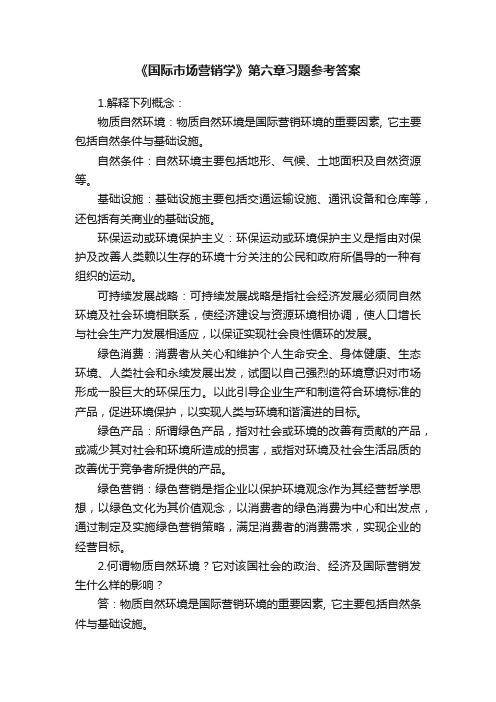
《国际市场营销学》第六章习题参考答案1.解释下列概念:物质自然环境:物质自然环境是国际营销环境的重要因素, 它主要包括自然条件与基础设施。
自然条件:自然环境主要包括地形、气候、土地面积及自然资源等。
基础设施:基础设施主要包括交通运输设施、通讯设备和仓库等,还包括有关商业的基础设施。
环保运动或环境保护主义:环保运动或环境保护主义是指由对保护及改善人类赖以生存的环境十分关注的公民和政府所倡导的一种有组织的运动。
可持续发展战略:可持续发展战略是指社会经济发展必须同自然环境及社会环境相联系,使经济建设与资源环境相协调,使人口增长与社会生产力发展相适应,以保证实现社会良性循环的发展。
绿色消费:消费者从关心和维护个人生命安全、身体健康、生态环境、人类社会和永续发展出发,试图以自己强烈的环境意识对市场形成一股巨大的环保压力。
以此引导企业生产和制造符合环境标准的产品,促进环境保护,以实现人类与环境和谐演进的目标。
绿色产品:所谓绿色产品,指对社会或环境的改善有贡献的产品,或减少其对社会和环境所造成的损害,或指对环境及社会生活品质的改善优于竞争者所提供的产品。
绿色营销:绿色营销是指企业以保护环境观念作为其经营哲学思想,以绿色文化为其价值观念,以消费者的绿色消费为中心和出发点,通过制定及实施绿色营销策略,满足消费者的消费需求,实现企业的经营目标。
2.何谓物质自然环境?它对该国社会的政治、经济及国际营销发生什么样的影响?答:物质自然环境是国际营销环境的重要因素, 它主要包括自然条件与基础设施。
自然环境影响国家的经济与社会发展:地理条件影响一个国家的交通运输与贸易的发展;地理条件影响一个国家社会的发展;自然资源的差异将影响世界经济发展与贸易发展的格局。
自然环境对国际营销的影响:影响产品的适应性;影响分销体系的设立及分销渠道的选择;自然条件影响企业的经营成本。
基础设施从以下几个方面影响国际营销:交通运输、通讯设备、商业基础设施。
《国际市场营销学》课后习题答案
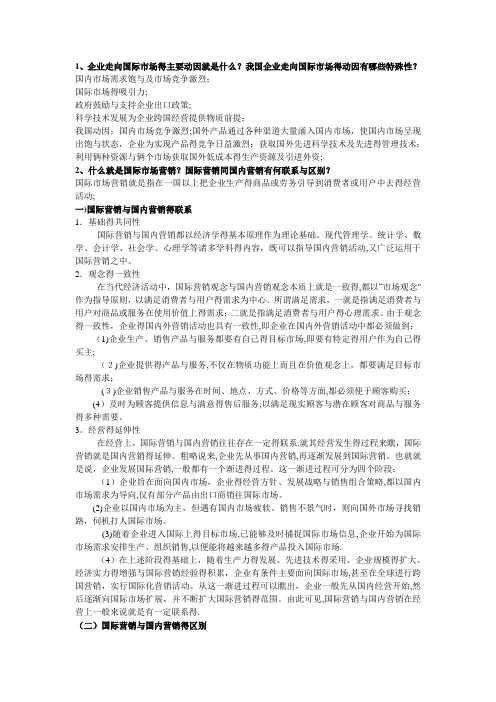
1、企业走向国际市场得主要动因就是什么?我国企业走向国际市场得动因有哪些特殊性?国内市场需求饱与及市场竞争激烈;国际市场得吸引力;政府鼓励与支持企业出口政策;科学技术发展为企业跨国经营提供物质前提;我国动因:国内市场竞争激烈;国外产品通过各种渠道大量涌入国内市场,使国内市场呈现出饱与状态,企业为实现产品得竞争日益激烈;获取国外先进科学技术及先进得管理技术;利用俩种资源与俩个市场获取国外低成本得生产资源及引进外资;2、什么就是国际市场营销?国际营销同国内营销有何联系与区别?国际市场营销就是指在一国以上把企业生产得商品或劳务引导到消费者或用户中去得经营活动;一)国际营销与国内营销得联系1.基础得共同性国际营销与国内营销都以经济学得基本原理作为理论基础。
现代管理学、统计学、数学、会计学、社会学、心理学等诸多学科得内容,既可以指导国内营销活动,又广泛运用于国际营销之中。
2.观念得一致性在当代经济活动中,国际营销观念与国内营销观念本质上就是一致得,都以“市场观念"作为指导原则,以满足消费者与用户得需求为中心。
所谓满足需求,一就是指满足消费者与用户对商品或服务在使用价值上得需求;二就是指满足消费者与用户得心理需求。
由于观念得一致性,企业得国内外营销活动也具有一致性,即企业在国内外营销活动中都必须做到:(1)企业生产、销售产品与服务都要有自己得目标市场,即要有特定得用户作为自己得买主;(2)企业提供得产品与服务,不仅在物质功能上而且在价值观念上,都要满足目标市场得需求;(3)企业销售产品与服务在时间、地点、方式、价格等方面,都必须便于顾客购买;(4)及时为顾客提供信息与满意得售后服务,以满足现实顾客与潜在顾客对商品与服务得多种需要。
3。
经营得延伸性在经营上,国际营销与国内营销往往存在一定得联系.就其经营发生得过程来瞧,国际营销就是国内营销得延伸。
粗略说来,企业先从事国内营销,再逐渐发展到国际营销。
也就就是说,企业发展国际营销,一般都有一个渐进得过程。
《国际市场营销学》第八章习题参考答案

1.解释下列概念:国际市场营销调研:国际市场营销调研是指企业运用科学的方法,有目的地、系统地搜集、记录一切与国际市场营销活动相关的信息,对所收集到的信息进行整理和分析,从而把握目标市场的变化规律,为国际市场上的营销决策提供可靠的依据。
文案调研:文案调研方式是指从各种文书档案中检索出有用的信息资料,再加以分析判断确定国际市场营销策略的一种以收集第二手资料为主的调研方式。
实地调研:实地调研是指市场调研信息资料直接来源于国际市场,从而取得第一手资料的调研方式。
问卷调查:问卷调查是将设计好的问卷寄给被调查者,请其回答后寄回以获取信息资料。
抽样调查:这是从调查对象的总体中按随机原则抽取一部分单位作为样本,对样本进行观测和调查,并以所观测和调查的样本指标推断或推算总体指标的一种非全面调查方法。
二手信息资料:第二手资料包括联合国、各国(地区)政府、贸易协会及其他组织公布的资料,企业内部记录和报告以及从各种渠道得到的间接资料。
第一手信息资料:是市场营销人员直接从顾客、中间商、推销员和竞争者等方面收集得来的第一手资料。
询问法:指采取询问方式向具有代表性的被调查者了解情况,从而获取原始信息资料的一种方法。
观察法:观察法:指由调研人员直接到现场,指由调研人员直接到现场,指由调研人员直接到现场,通过工具、机器或直观方法,通过工具、机器或直观方法,通过工具、机器或直观方法,观察被调查者观察被调查者的行动和表情,收集原始资料。
实验法:实验法:指在一定的小范围市场指在一定的小范围市场指在一定的小范围市场(样本空间)(样本空间)(样本空间)内,对某一购买行为进行实验性的内,对某一购买行为进行实验性的统计性观察,从而了解其因果关系的一种重要方法。
2.国际市场营销调研主要包括哪些内容?答:国际市场营销环境调研:国际自然环境;人口资源;国民收入;各国社会和文化;国际政治环境;国际经济环境。
国际市场的消费者调研:消费者调研;消费量调研。
国际市场营销课后习题答案.

《国际市场营销理论与实务》(第2版)习题答案仅供参考第一章国际市场营销概述一、单项选择题C C B C B二、多项选择题1.ABDE2.ABCD3.ACDE三、简答题1.简述国际营销和国际贸易的异同(1)相同点。
国际市场营销与国际贸易都是以获得利润收入为目的而进行的跨越国境的经济活动。
(2)不同点。
①所依据的理论点不同;②商品(劳务)交换的行为主体不同;③强调重点不同;④商品(劳务)转移的形态不同;⑤国际市场营销涉及企业整体发展战略问题;⑥评价绩效的信息来源不同。
2.简述企业走向国际市场的主要动因(1)国际营销的竞争动因①避开竞争锋芒。
②追逐竞争对手。
③锻炼竞争能力。
④延长产品生命周期,发挥竞争优势。
(2)国际营销的资源动因①开发自然资源。
②利用劳动力资源。
③获取技术资源。
④赢取信息资源。
(3)国际营销的利润动因①通过规模效应,获得更大利润。
②利用资源优势,获得更大利润。
③利用优惠政策,获得更大利润。
同时,一些国家为了吸引外商投资,在税收等方面采取一系列优惠政策。
国际企业也可以通过东道国政府的优惠政策获得更大的收益。
3.试区别国营销、出口营销、国际营销、多国营销、全球营销(1)国营销。
国营销是指国市场为企业唯一的经营围,企业经营的目光、焦点、导向及经营活动集中于国消费者、国供应商、国竞争者。
其公司在国从事营销活动可能是有意识的、自觉的战略选择,活着是无意识的、不自觉的想躲避国外竞争者的挑战,有时甚至由于对外界环境的无知而造成“出口恐惧症”,对出口销售持消极态度。
(2)出口营销。
出口营销时期一般指20世纪第二次世界大战后至60年代。
但是,此阶段仍以出口产品为主组织国际市场营销活动,对国际市场调研、产品开发的自觉性还不够。
这是企业进入国际市场的第一阶段。
其目标市场是国外市场,企业在国生产产品到国外销售,满足国外市场需求。
在这一阶段产品与经验成为发展出口营销的关键。
同时,国际营销者还要研究国际目标市场,使产品适应每个国家的特殊要求。
《国际市场营销》课后习题参考答案

《国际市场营销》课后习题参考答案学习情境一走进国际市场营销一、简述题1.试区分国内市场营销、国际贸易与国际市场营销。
答:(1)国际市场营销与国际贸易的主要区别是:角度不同,范围不同,流向不同,对象不同。
(2)国际市场营销与国内市场营销相比,除了跨国性、异国性、多国性以外,更有复杂性、风险性、激烈性的特征。
2.试讨论国际市场营销学发展的不同阶段。
答:企业国际市场营销的发展同世界经济一体化及本国市场经济的发展是紧密相连的,其发展演变经历了一个过程,即国内市场营销→出口营销→国际市场营销→多国营销→全球营销。
从现实看,众多国家的企业仍处于国际市场营销阶段,少数发达国家的跨国公司已进入全球营销阶段。
3.试述几种国际市场营销观念的区别。
答:在西方国家企业的营销活动中,先后出现了五种营销观念,即生产观念、产品观念、推销观念、市场营销观念和社会市场营销观念。
在市场国际化、全球化、竞争激烈化的发展形势下,国际市场营销新观念也应运而生。
(1)生产观念:生产观念是以产品生产为中心的观念。
(2)产品观念:产品观念也是以产品生产为中心,但它认为:消费者并不是仅关注买得到和买得起的产品,更欢迎那些质量高、性能好、有特色、价格合理的产品。
(3)销售观念。
销售观念是一种以产品销售为中心的观念。
它认为:只要企业努力做好产品推销,消费者就会购买。
(4)市场营销观念。
市场营销观念是一种以消费者的需求为中心的经营思想。
它认为企业的一切活动都应以消费者中心,满足消费者的需求是企业的责任。
(5)社会营销观念。
社会营销观念是一种以社会利益为中心的市场营销观念。
它认为:企业不仅要考虑消费者的现实需求,更要考虑潜在需求;要善于引导消费,在获取效益的同时,还要考虑生态效益和社会效益。
4.你认为中国500强企业应如何开展跨国营销活动?答:我国企业在国际营销中存在的问题是体制上、观念上等多方面复杂因素相互作用的结果,要解决这些问题,需要政府和企业共同努力采取相应的对策。
国际市场营销课后习题答案.doc

《国际市场营销理论与实务》(第2版)习题答案仅供参考第一章国际市场营销概述一、单项选择题C C B C B二、多项选择题1.ABDE2.ABCD3.ACDE三、简答题1.简述国际营销和国际贸易的异同(1)相同点。
国际市场营销与国际贸易都是以获得利润收入为目的而进行的跨越国境的经济活动。
(2)不同点。
①所依据的理论点不同;②商品(劳务)交换的行为主体不同;③强调重点不同;④商品(劳务)转移的形态不同;⑤国际市场营销涉及企业整体发展战略问题;⑥评价绩效的信息来源不同。
2.简述企业走向国际市场的主要动因(1)国际营销的竞争动因①避开竞争锋芒。
②追逐竞争对手。
③锻炼竞争能力。
④延长产品生命周期,发挥竞争优势。
(2)国际营销的资源动因①开发自然资源。
②利用劳动力资源。
③获取技术资源。
④赢取信息资源。
(3)国际营销的利润动因①通过规模效应,获得更大利润。
②利用资源优势,获得更大利润。
③利用优惠政策,获得更大利润。
同时,一些国家为了吸引外商投资,在税收等方面采取一系列优惠政策。
国际企业也可以通过东道国政府的优惠政策获得更大的收益。
3.试区别国内营销、出口营销、国际营销、多国营销、全球营销(1)国内营销。
国内营销是指国内市场为企业唯一的经营范围,企业经营的目光、焦点、导向及经营活动集中于国内消费者、国内供应商、国内竞争者。
其公司在国内从事营销活动可能是有意识的、自觉的战略选择,活着是无意识的、不自觉的想躲避国外竞争者的挑战,有时甚至由于对外界环境的无知而造成“出口恐惧症”,对出口销售持消极态度。
(2)出口营销。
出口营销时期一般指20世纪第二次世界大战后至60年代。
但是,此阶段仍以出口产品为主组织国际市场营销活动,对国际市场调研、产品开发的自觉性还不够。
这是企业进入国际市场的第一阶段。
其目标市场是国外市场,企业在国内生产产品到国外销售,满足国外市场需求。
在这一阶段产品与经验成为发展出口营销的关键。
同时,国际营销者还要研究国际目标市场,使产品适应每个国家的特殊要求。
《国际市场营销学》课后习题答案讲课稿

《国际市场营销学》课后习题答案1.企业走向国际市场的主要动因是什么?我国企业走向国际市场的动因有哪些特殊性?国内市场需求饱和及市场竞争激烈;国际市场的吸引力;政府鼓励与支持企业出口政策;科学技术发展为企业跨国经营提供物质前提;我国动因:国内市场竞争激烈;国外产品通过各种渠道大量涌入国内市场,使国内市场呈现出饱和状态,企业为实现产品的竞争日益激烈;获取国外先进科学技术及先进的管理技术;利用俩种资源与俩个市场获取国外低成本的生产资源及引进外资;2.什么是国际市场营销?国际营销同国内营销有何联系和区别?国际市场营销是指在一国以上把企业生产的商品或劳务引导到消费者或用户中去的经营活动;一)国际营销与国内营销的联系1.基础的共同性国际营销与国内营销都以经济学的基本原理作为理论基础。
现代管理学、统计学、数学、会计学、社会学、心理学等诸多学科的内容,既可以指导国内营销活动,又广泛运用于国际营销之中。
2.观念的一致性在当代经济活动中,国际营销观念与国内营销观念本质上是一致的,都以“市场观念”作为指导原则,以满足消费者和用户的需求为中心。
所谓满足需求,一是指满足消费者和用户对商品或服务在使用价值上的需求;二是指满足消费者和用户的心理需求。
由于观念的一致性,企业的国内外营销活动也具有一致性,即企业在国内外营销活动中都必须做到:(1)企业生产、销售产品与服务都要有自己的目标市场,即要有特定的用户作为自己的买主;(2)企业提供的产品和服务,不仅在物质功能上而且在价值观念上,都要满足目标市场的需求;(3)企业销售产品与服务在时间、地点、方式、价格等方面,都必须便于顾客购买;(4)及时为顾客提供信息和满意的售后服务,以满足现实顾客和潜在顾客对商品和服务的多种需要。
3.经营的延伸性在经营上,国际营销与国内营销往往存在一定的联系。
就其经营发生的过程来看,国际营销是国内营销的延伸。
粗略说来,企业先从事国内营销,再逐渐发展到国际营销。
闫国庆_国际市场营销(第三版)_习题案例答案_第5章

复习思考题参考答案第五章⒈请举例说明国际政治风险的源泉和类型。
参考答案:政治风险的源泉主要有两个:一个是政治主权, 另一个是政治冲突。
政治冲突具体有暴动、内战和政治阴谋。
政治冲突具有两种效果:一个是直接效果;另一个是间接效果。
直接效果表现为暴力、掠夺和罢工等形式。
间接效果表现为解决问题的纯动机和以其它问题转移国民大众关心的动机。
美国的Leontiades教授于1985年把政治风险划分为以下四种类型。
(1) 对外国企业经营方面的限制规定。
它包括对外国企业生产的产品利益以及资产等所征收的差别税;政府购买中显现出来的本国企业和外国企业的差别;对外国企业产品的价格控制;对市场营销等企业经营活动所采取的官僚主义行政性限制规定等。
(2) 经营管理的本国化。
它包括对外国职员人数的限制;董事会任命的人员当中规定必须超过一定比例以上人员是本国人。
(3) 资本的本国化。
它包括合作投资的要求、逐步本国化、阶段性的所有权缩小等政策。
(4) 资产损失危险。
它包括禁止或限制资金转移的政策,以适当补偿为条件的国有化,财产没收、占用、惩罚、强行出售、强行再协商及单方面破坏契约等。
美国的Root教授于1982年把政治风险划分为以下四种类型。
(1) 一般性不安定危险。
它包括革命、军事政变、内乱及战争爆发的可能性。
(2) 所有权及控制危险。
它包括国有化、没收财产及占用等各种资产损失危险。
(3) 运营危险。
它包括收入限制、零部件的当地化规定、征税差别、价格控制、经营者中外国人数的限制、雇佣当地人的比例规定、出口规定及各种对外国企业的差别规定。
(4) 转移性危险。
它包括在当地子公司的利益和资本全转移到本国时,当地政府对其所采取的限制措施。
⒉国际政治风险的预测评价方法有定性预测方法和定量预测方法,如果让你对国际政治风险进行预测评价,你喜欢用哪一种定性预测方法和定量预测方法?并具体解释这两种方法的含义。
参考答案:预测方法主要有两种:一种是定性预测方法,另一种是定量预测方法。
国际市场营销学甘碧群第四版答案
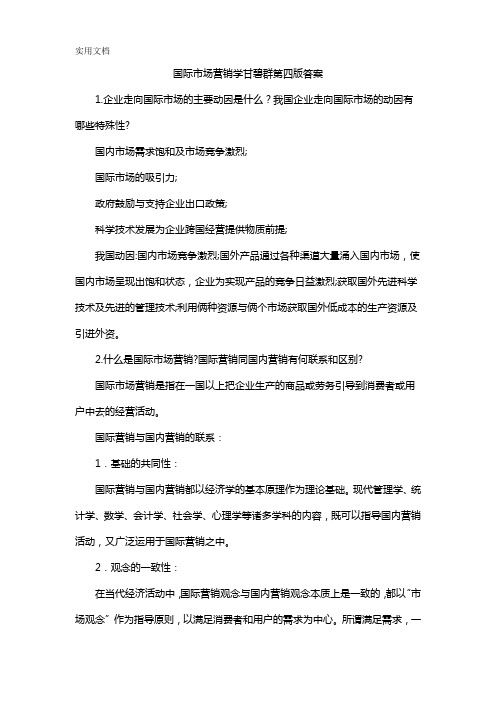
国际市场营销学甘碧群第四版答案
1.企业走向国际市场的主要动因是什么?我国企业走向国际市场的动因有哪些特殊性?
国内市场需求饱和及市场竞争激烈;
国际市场的吸引力;
政府鼓励与支持企业出口政策;
科学技术发展为企业跨国经营提供物质前提;
我国动因:国内市场竞争激烈;国外产品通过各种渠道大量涌入国内市场,使国内市场呈现出饱和状态,企业为实现产品的竞争日益激烈;获取国外先进科学技术及先进的管理技术;利用俩种资源与俩个市场获取国外低成本的生产资源及引进外资。
2.什么是国际市场营销?国际营销同国内营销有何联系和区别?
国际市场营销是指在一国以上把企业生产的商品或劳务引导到消费者或用户中去的经营活动。
国际营销与国内营销的联系:
1.基础的共同性:
国际营销与国内营销都以经济学的基本原理作为理论基础。
现代管理学、统计学、数学、会计学、社会学、心理学等诸多学科的内容,既可以指导国内营销活动,又广泛运用于国际营销之中。
2.观念的一致性:
在当代经济活动中,国际营销观念与国内营销观念本质上是一致的,都以“市场观念”作为指导原则,以满足消费者和用户的需求为中心。
所谓满足需求,一
是指满足消费者和用户对商品或服务在使用价值上的需求;二是指满足消费者和用户的心理需求。
由于观念的一致性,企业的国内外营销活动也具有一致性,即企业在国内外营销活动中都必须做到:
(1)企业生产、销售产品与服务都要有自己的目标市场,即要有特定的用户作为自己的买主;
(2)企业提供的产品和服务,不仅在物质功能上而且在价值观念上,都要满足目标市场的需求。
《国际市场营销学》参考答案
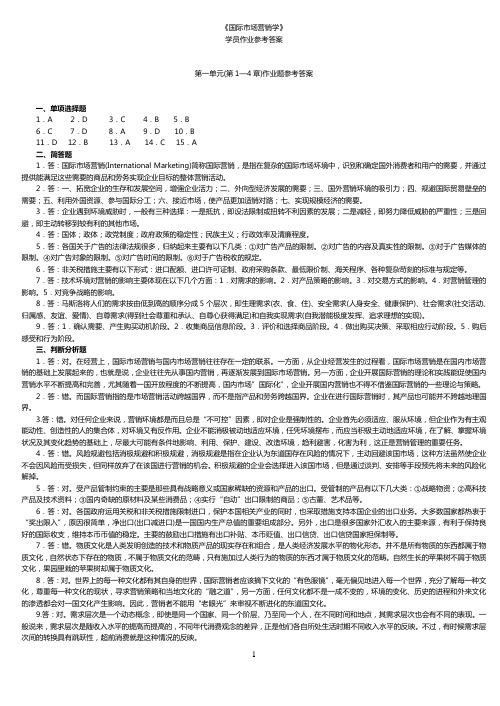
《国际市场营销学》学员作业参考答案第一单元(第1—4章)作业题参考答案一、单项选择题1.A 2.D 3.C 4.B 5.B6.C 7.D 8.A 9.D 10.B11.D 12.B 13.A 14.C 15.A二、简答题1.答:国际市场营销(International Marketing)简称国际营销,是指在复杂的国际市场环境中,识别和确定国外消费者和用户的需要,并通过提供能满足这些需要的商品和劳务实现企业目标的整体营销活动。
2.答:一、拓宽企业的生存和发展空间,增强企业活力;二、外向型经济发展的需要;三、国外营销环境的吸引力;四、规避国际贸易壁垒的需要;五、利用外国资源、参与国际分工;六、接近市场,使产品更加适销对路;七、实现规模经济的需要。
3.答:企业遇到环境威胁时,一般有三种选择:一是抵抗,即设法限制或扭转不利因素的发展;二是减轻,即努力降低威胁的严重性;三是回避,即主动转移到较有利的其他市场。
4.答:国体;政体;政党制度;政府政策的稳定性;民族主义;行政效率及清廉程度。
5.答:各国关于广告的法律法规很多,归纳起来主要有以下几类:①对广告产品的限制。
②对广告的内容及真实性的限制。
③对于广告媒体的限制。
④对广告对象的限制。
⑤对广告时间的限制。
⑥对于广告税收的规定。
6.答:非关税措施主要有以下形式:进口配额、进口许可证制、政府采购条款、最低限价制、海关程序、各种复杂苛刻的标准与规定等。
7.答:技术环境对营销的影响主要体现在以下几个方面:1.对需求的影响。
2.对产品策略的影响。
3.对交易方式的影响。
4.对营销管理的影响。
5.对竞争战略的影响。
8.答:马斯洛将人们的需求按由低到高的顺序分成5个层次,即生理需求(衣、食、住)、安全需求(人身安全、健康保护)、社会需求(社交活动、归属感、友谊、爱情)、自尊需求(得到社会尊重和承认、自尊心获得满足)和自我实现需求(自我潜能极度发挥、追求理想的实现)。
9.答:1.确认需要、产生购买动机阶段。
- 1、下载文档前请自行甄别文档内容的完整性,平台不提供额外的编辑、内容补充、找答案等附加服务。
- 2、"仅部分预览"的文档,不可在线预览部分如存在完整性等问题,可反馈申请退款(可完整预览的文档不适用该条件!)。
- 3、如文档侵犯您的权益,请联系客服反馈,我们会尽快为您处理(人工客服工作时间:9:00-18:30)。
第一章1、国际市场营销学:是一门研究以国外顾客需求为中心、从事国际市场营销活动的国际企业经营管理的科学。
2、国际市场营销学与市场营销学、国际贸易学的区别与联系是什么?答:国际市场营销学与市场营销学的关系与区别联系:①理论基础相同②经营理念相同③市场边界的扩大区别:①国际市场环境更加复杂②国际市场营销面对更多不确定因素③国际市场营销方案更多样化④国际市场营销的难度更大国际市场营销与国际贸易的联系与区别联系:①国际贸易是国际市场营销的先导。
②企业的国际市场营销是国际贸易的一部分。
区别:①经营主体不同②商品的流通形态不同③经营动力或行为动机不同④评价经济效益的信息来源不同⑤国际市场营销活动的作业流程比国际贸易更加复杂3、企业开展国际市场营销的动因是什么?答:⑴国内市场竞争激烈,利润微薄促使企业走向国际市场⑵企业走向国际市场以延长其产品的生命周期⑶国际市场需求潜力大、机会多⑷对低成本的追求⑸对东道国丰富和廉价资源的吸引⑹本国政府的支持和鼓励⑺东道国市场环境和基础设施条件的吸引4、国际市场营销的发展过程是什么?答:⑴国内营销阶段⑵出口营销阶段⑶国际市场营销阶段5、国际市场的研究内容有哪些?答:研究对象:国际市场需求、国际市场营销活动、国际市场营销规律研究内容:国际市场营销环境、国际市场的选择、国际市场的调研、国际市场营销规划与组织、国际市场营销信息系、国际市场营销策略、国际市场竞争战略。
第二章1、国际政治环境:是指东道国直接或间接影响和制约国际市场营销的各种政治因素的集合,其内容主要涉及政府与政党体制、政府政策和政治风险。
2、国际法律环境:影响国际企业开展国际市场营销活动的法律主要有国内法律国际法律和东道国法律构成了国际法律环境。
3、如何评估国际政治环境?答:⑴专家调查法⑵实地考察法⑶利用驻外专家调查法⑷利用国际咨询机构法⑸政治体制稳定指数(PSSI)法4、采取什么措施以防范国际政治风险?答:⑴回避策略⑵保险策略⑶当地化策略⑷建立合资企业策略⑸树立良好的企业形象策略⑹积极参与东道国经济建设策略5、国际商务争端的解决途径有哪些?答:(1)协商:是指在发生商务争端之后,各方当事人约定在自愿互谅互让、相互妥协的基础上,依据相关法律和合同条款的规定,达成各方都能接受的解决方案。
(2)调解:是指在中立的第三方主持下,即调解人的主持下,做商务争端各方当事人的工作,排解疏导,各方互谅互让,消除争端,化解矛盾达成协议(3)仲裁:是指在国际商务争端发生之后,当事人各方通过协议,自愿将他们之间的商务争端提交给仲裁机构审理和裁决,并自觉履行其裁决所应当承担的义务的一种制度。
(4)诉讼:是当事人任何人一方向对商务争端案件有管辖权的法庭诉讼,通过司法途径解决争端。
6、在解决商务争端时,为什么司法诉讼是企业迫不得已的选择?答:(1)可能对当事人各方之间的关系产生较大的损害(2)法官对国际贸易问题不一定很精通,可能会产生不公平的判决(3)难以收到所判决的罚款(4)诉讼耗时长,花费高(5)诉讼使涉及的相关内容公开,不能保密。
第三章1、国际企业熟悉东道国的文化环境有什么重要性?答:(1)有利于国际企业开拓国际市场时避免遭受失败。
(2)有利于国际企业创造消费者的需求偏好。
(3)有利于国际企业抓住市场机会。
(4)有利于国际企业提高产品的竞争力。
2、国际文化环境是由哪些因素构成的?答:物质文化、语言、肢体语言、美学、教育、宗教、社会组织、价值观、传统习惯3、东道国国民教育水平高低对国际企业营销活动会产生什么影响?(1)教育水平的高低影响其持有的价值观念,从而影响其消费行为。
(2)教育水平的高低影响其现有的生活方式,进而影响其消费行为。
(3)教育水平的高低影响国际企业营销策略的选择。
4、国际企业为什么要适应东道国的宗教文化?(1)人的宗教信仰对其社会价值观的形成会产生巨大影响,支配着人们认识事物的方式、价值观、需求偏好和购物方式,对产品的接受、对国际企业销策略的认可(2)国际企业如果违背了宗教禁忌,在经济上和政治上都会受到损失。
(3)国际企业利用宗教的习俗,生产出满足其特殊需要的产品,产品自然就会畅销,会提高国际企业的竞争力。
5、东道国国民的价值观对国际企业的营销活动会产生什么影响?(1)价值观规范了人们的行为方式,确定了东道国消费者的生活和消费方式。
(2)利用目标市场国消费者的价值观开展营销活动,会使其产品更好满足该国的市场需求。
6、文化冲突是指国际企业以本国文化参照对象,到目标市场国家展开营销活动,因与当地文化不相符合,产生矛盾,导致当地消费者抵制的现象。
在东道国的公司的高级主管和产品设计人员尽可能利用当地人,因为他们熟悉当地文化,他们是站在东道国消费者的立场上开展营销活动的,这样就不会产生文化冲突,从而容易取得成功。
第四章1、国际经济环境有哪些环境构成?答:本国经济环境、区域经济环境、全球经济环境、全球人口环境、国际金融环境2、什么是区域经济一体化?区域经济一体化怎样对国际市场营销产生影响?答:区域经济一体化是指:区域内各成员国相互取消贸易障碍,进行一定程度的合作与协作,以促进成员国之间的贸易与经济发展。
3、世界贸易组织的基本原则有哪些?答:非歧视贸易、自由贸易、可预知性、促进公平竞争、鼓励发展和经济改革4、对外直接投资是指:一国的企业或个人通过在国外设立子公司或分公司,或通过购买、参与当地企业的股份,直接在海外从事生产、销售和其他经营活动的投资形式。
5、汇率的种类及影响汇率变化的因素有哪些?答:汇率的种类:(1)固定汇率制度:是指两国货币的汇率基本固定,只允许在一定的范围内浮动(2)浮动汇率制度:是指一国政府不规定本国的官方汇率,外汇汇率是由外汇市场根据外汇的供求状况自发地决定的。
影响因素有:贸易差额、通货膨胀、利率、经济状况、外汇管制、重大国际事件、心理因素。
6、国际金融环境和外汇外汇环境对国际企业产生什么影响?答:(1)对企业产品的国际竞争力的影响。
(2)对吸引国外企业前来投资的影响(3)对企业的营销策略的影响(4)对企业进出口影响。
外汇汇率的波动会导致货币的升值或贬值。
升值有利于进口不利于出口。
(5)对企业的决策产生影响(6)对企业财务管理的影响第五章1、科学技术环境对国际市场营销有哪些影响?答:(1)科学技术的发展直接影响企业的活动。
(2)科学技术的发展和应用影响企业的国际营销决策。
(3)科学技术的发展为提高营销效率提供了更新、更好的物质条件。
(4)科学技术的发展改变了企业的经营观念。
2、电子商务对国际营销产生什么影响?答:(1)电子商务提高了国际企业国际营销的效率。
(2)电子商务改变了国际企业国际营销的方式。
(3)电子商务引起消费者及其行为的变化。
(4)电子商务引发企业营销理念的变化。
(5)电子商务使企业营销管理重心发生变化。
3、电子商务对国际企业有什么要求?答:(1)电子商务要求国际企业转变营销观念(2)电子商务要求企业加强协作,实现共赢。
(3)电子商务要求企业进行营销创新。
(4)电子商务要求企业勇于进行技术创新。
4、网络营销有什么特点?答:跨时空、多媒体、交互式、拟人化、成长性、整合性、超前性、高效性、经济性、技术性。
5、网络营销对传统营销产生怎样的冲击?答:(1)对产品的策略的影响(2)对定价策略的影响(3)对营销渠道的冲击(4)对促销的影响第六章1、国际营销中的自然环境包括那些?答:自然资源气候条件地理位置地形地貌2、国际自然环境对企业国际营销会产生什么影响?答:(1)自然环境影响一国和地区的经济贸易发展。
(2)自然环境影响消费者的行为。
(3)自然环境影响产品的供求。
(4)自然环境影响国际营销产品的选择。
(5)自然环境影响国际营销产品改进。
(6)自然环境影响国际营销时机选择。
3、如何使国际营销有利于实现消费者利益的持续发展?答:(1)国际营销应当有利于实现社会利益的持续发展。
(2)国际营销应当有利于实现消费者利益的持续发展。
(3)国际营销应当有利于实现企业利益的持续发展。
第七章1、影响国际区域市场形成的因素有哪些?答:经济因素、政治因素、文化因素、地理因素2、北美市场环境有什么特点?中国企业如果要进入北美市场,哪些方面需要加强?答:特点:(1)都是发达国家,经济发达。
(2)社会文化环境较为稳定(3)自然环境质量高。
(4)政治环境较为稳定。
(5)技术环境:技术变革步伐快、技术革新的机会多、技术革新规定多3、欧盟对本区域的消费者有哪些保护?这样些法规分别起什么作用?4、开发广大的非洲市场时,会面临哪些市场环境的困难?答:(1)人口增长快,,经济发展滞后,人口的科学文化水平极其低下。
(2)经济发展水平低,城市化程度低,基础设施条件差。
(3)封闭农业文化性明显;浓烈的部落意识、牢固的自然经济和非常多的陈腐的习俗非常多导致缺乏商品、市场等经济意识。
(4)科技事业普遍衰退,科技教育不振,技术力量很薄弱。
(5)某些地区的政局仍不稳定。
第八章1、国际企业为什么要开展国际营销调研活动?答:(1)有助于国际企业发现国际营销机会,开拓潜在的国际市场。
(2)为国际企业进行国际营销组合决策提供依据。
(3)有助于国际企业评价国际营销活动的效果,并为调整营销策略提供依据。
(4)有助于国际企业预测国际市场的发展变化规律。
2、国际营销调研的程序有哪些?答:①确定调研问题和目标②制定调研计划③收集信息④分析信息⑤撰写调研报告3、国际营销调研的方法有哪些?答:(1)访问法:人员访问,电话访问,邮寄访问,网上访问(2)观察法:是指调查者凭借自己的眼睛或摄像录音仪器,在调查现场进行实地地考察,记录正在发生的市场行为或状况,以获取各种原始资料的一种调研方法。
(3)实验法:是指在控制的条件下对所研究的现象的一个或多个因素进行操纵,以测定这些因素之间关系的方法。
4、国际营销调研中常见的问题和对应之策是什么?答:5、国际营销调研系统包括哪些内容?各个子系统各起什么作用?答:(1)内部报告系统:通过对企业经营状况信息的信息,国际营销管理人员能够发现市场机会,找出管理中存在的问题,同时可以比较实际情况与预期水准之间的差异。
(2)营销情报系统:利用各种方法收集、侦查和提供企业国际营销环境最新发展的信息。
(3)营销调研系统:系统地、客观地识别、收集、分析和传递有关国际市场营销活动中各方面的信息,提出与企业有关的特定的国际营销问题的研究报告,以帮助国际营销管理者制定有效的国际营销决策。
(4)营销分析系统:对复杂的国际市场现象进行统计分析,建立数学模型,能有效地帮助营销管理人员分析复杂的国际市场营销问题,做出最佳的国际市场营销决策。
第九章1、什么是国际市场宏观细分?国际市场宏观细分的变量主要有哪些?答:国际市场宏观细分:是指按照地理位置、经济水平及社会文化水平的差异,将国际市场分为若干个子市场,且每一个子市场具有某些共同的特征。
